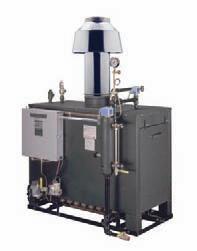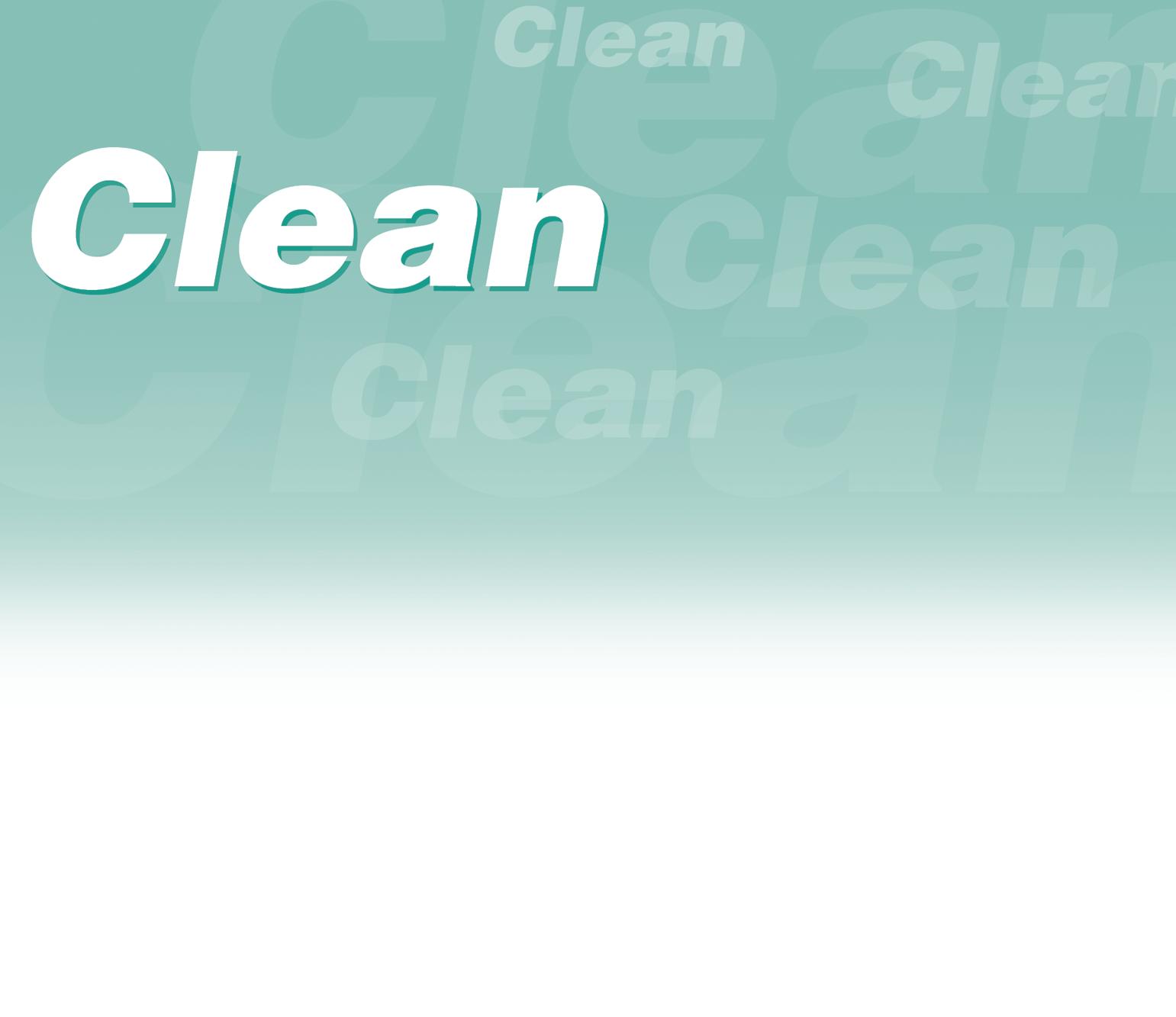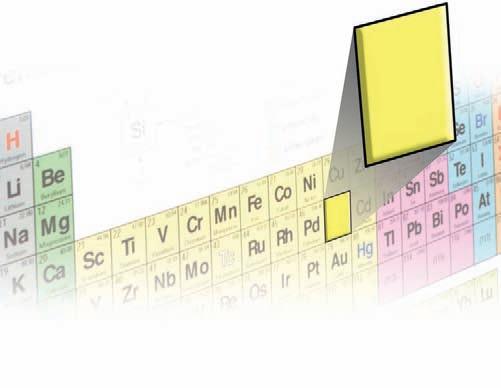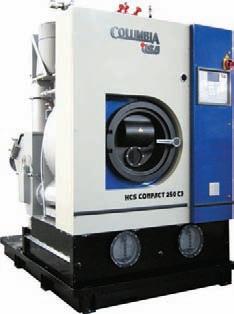








EasyGo quickly penetrates fabric to release ground-in soil, collar and cuff stains, perspiration, etc. Simply spray soiled areas before drycleaning. No brushing, flushing or waiting required. Stains and soil disappear right in the wheel. EasyGo works as a leveling agent too!

And EasyGo is environmentally friendly. It’s soy based, biodegradable, non-combustible and California 2013 VOC and Prop-65 compliant. Just spray it on and dryclean it out. With EasyGo, it’s just that easy!
To learn more, visit ALWilson.com or call 800-526-1188. A. L. Wilson Chemical Co.
never been so easy.
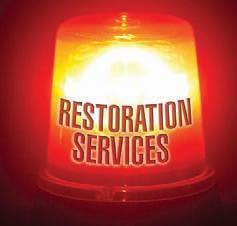
















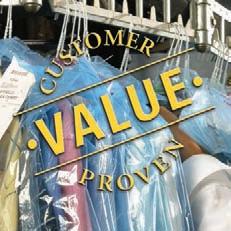
Since 2003, CBS has given me consistent updates and easy to understand tech support, all at a price that our industry can afford. I would recommend CBS, and I have, to anyone who is still wasting their time and money on those over priced POS systems. DanLoesher SunshineCleaners
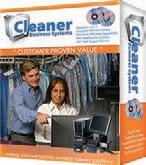





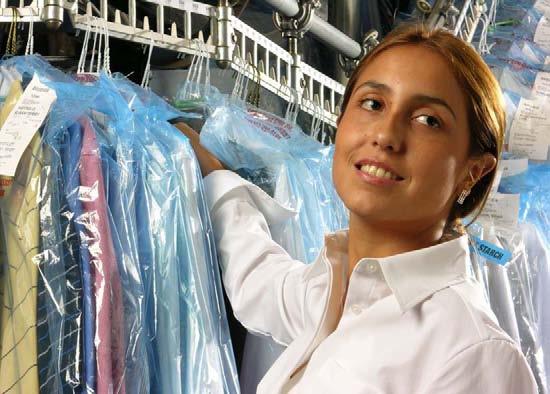
When you’re able to remove that wine stain from her favorite dress, Mrs. Jane Q. Public may say something like, “I never thought I’d be able to wear this again. You’re a lifesaver!”
possessions. But the value of their ability to restore a family’s garments and soft goods after a disaster, to the insurance carrier and to the family, shouldn’t be understated, either.
Bruce Beggs
I’d say the closest thing to being a lifesaver in the dry cleaning industry is providing restoration services to the insurance industry (see our story beginning on page 32).
Now, cleaners that offer this service don’t rush to the scene of a still-burning house fire and break down the door to save a family’s
Publisher
Charles Thompson 312-361-1680 cthompson@american trademagazines.com
Editorial Director Bruce Beggs 312-361-1683 bbeggs@american trademagazines.com
Production Manager
Roger Napiwocki
National Sales Director

Donald Feinstein 312-361-1682 dfeinstein@american trademagazines.com

Digital Media Director
Nathan Frerichs 312-361-1681 nfrerichs@american trademagazines.com Main: 312-361-1700 Fax: 312-361-1685

In her column this month (page 14), Diana Vollmer approaches restoration services from an operations perspective, analyzing opportunities in the niche market.
To paraphrase her, disaster restoration can be a good addition to your offerings, but due to the varied demands it places on the average operation, it is not for the casual participant, the timid, or the faint of heart.
Maybe she should have added that it’s for the “lifesavers.” O
American Drycleaner (ISSN 0002-8258) is published monthly except Nov/Dec combined. Subscription prices, payment in advance: U.S. and Possessions, 1 year $39.00; 2 years $73.00. Foreign, 1 year $89.00; 2 years $166.00. Single copies $7.00 for U.S. and Possessions, $14.00 for all other countries. Published by American Trade Magazines LLC, 566 West Lake Street, Suite 420, Chicago, IL 60661. Periodicals postage paid at Chi cago, IL and at additional mailing offices.
POSTMASTER, Send changes of address and form 3579 to American Drycleaner, Subscription Dept., 440 Quadrangle Drive, Suite E, Bolingbrook, IL 60440 Volume 79, number 11. Editorial, executive and advertis ing offices are at 566 West Lake Street, Suite 420, Chicago, IL 60661. Charles Thompson, President and Publisher. American Drycleaner is distributed selectively to: qualified dry cleaning plants and distributors in the United States. No material appearing in American Drycleaner may be reprinted without written permission. The publisher reserves the right to reject any advertising for any reason. © Copyright AMERICAN TRADE MAGA ZINES LLC, 2013. Printed in U.S.A.
American Drycleaner, March 2013 www.americandrycleaner.com
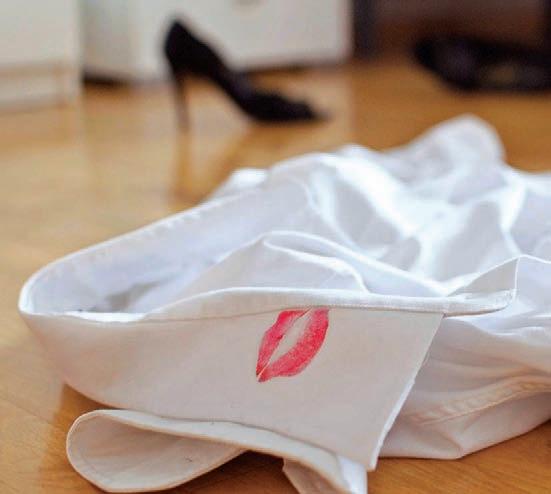

CHICAGO — Google the terms “dry cleaner” and “robbed” and you’re likely to find several news reports of incidents that have occurred in the past month or so. Yes, dry cleaners’ cash business can be an attraction for robbers, and minimally staffed drop stores can be targeted.
In February’s Wire survey from AmericanDrycleaner.com, members of the trade audience were asked if any of their stores had ever been victimized by criminals. Nearly 43% of respondents said their businesses had been victimized in the past.

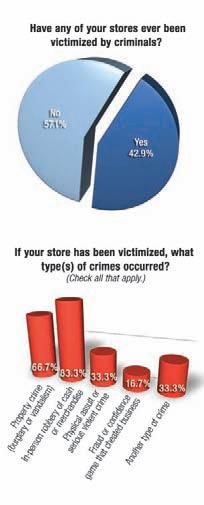
Of those incidents, 83.3% involved an “in-person robbery of cash or merchandise” and 66.7% involved a “property crime such as burglary or vandalism.” One-third of respondents also said someone in their store had been involved in a “physical assault or serious violent crime” or “another type of crime,” including receiving counterfeit bills. Just 16.7% said they had been victimized by a “fraud or confidence game that cheated the business.”
Approximately 64% of dry cleaners who took the survey said their employees receive training specific to how they should respond in the event a crime is committed in their store.
How do dry cleaners deter crime?
Among respondents, 64.3% use video cameras and 50% use alarm systems.
Equal shares of 14.3% have firearms or oth er weapons, or use “another deterrent,” such as posting warning signs or keeping only small amounts of cash in the cash drawer. Nearly a quarter of respondents—21.4%— don’t have a crime deterrent.
While the Wire survey presents a snap shot of readers’ viewpoints at a particular moment, it should not be considered scien tific.
Subscribers to Wire e-mails—delivered twice weekly—are invited to take a brief industry survey anonymously online each month. All dry cleaners are encouraged to participate, as a greater number of re sponses will help to better define opinions and industry trends.
WASHINGTON — Falling crude oil prices will help continue to push the re tail price of gasoline lower this year and next, according to the Short-Term Energy Outlook produced in January by the U.S. Energy Information Administration (EIA).
EIA expects that falling crude prices will help national regular gasoline retail prices fall from an average of $3.63 per gallon in 2012 to annual averages of $3.44 per gallon in 2013 and $3.34 per gallon in 2014.
Diesel fuel retail prices averaged $3.97 per gallon during 2012 and are forecast to fall to an average of $3.87 per gallon in 2013 and $3.78 per gallon in 2014.
Meanwhile, the cost of natural gas is expected to go up, EIA reports. Working inventories, which were at record-high
Top stories @ AmericanDrycleaner.com for the 30 days ending Feb. 15
Top News sTories
1. Entrepreneur Launches New Convenience-Centric Dry Cleaning Brand
2. Franchisors Announce Openings of New Dry Cleaners
3. Survey: Many Dry Cleaners Optimistic About Meeting 2013 Goals
Top columNs & FeATures
1. The Changing of the Tide
2. Perception is Reality
3. StatShot: West Only Region to Register Better Dry Cleaning Sales ... Web eXCLUSIVe!

Top sTories @ our sisTer siTes
Americancoinop.com:
1. Maytag Concept Stores Debut in North America
2. Perfecting Wash/Dry/Fold Service
3. Bipartisan Task Force Backs Shift to Dollar Coin Web eXCLUSIVe!
AmericanlaundryNews.com:
1. 2013 Panel of Experts Ready to Answer... 2. Survey: Laundry Managers Split on...
3. Healthcare Laundry in 2033: Predictions
levels in early November, ended 2012 at an estimated 3.5 trillion cubic feet (Tcf), slightly above the level at the same time the previous year.
EIA expects the Henry Hub natural gas spot price, which averaged $4 per million B ritish thermal units (MMBtu) in 2011 and $2.75 per million MMBtu in 2012, to average $3.74 per MMBtu in 2013 and $3.90 per MMBtu in 2014. O
American Drycleaner, March 2013 www.americandrycleaner.com
Our POS computer solutions for drycleaners help spread the joy around. Customers get great service, clerks appreciate the efficiency, and owners are pleased with all of the positive results.
The following Fabricare Manager user expresses it very well:
Your ability to help us stay on top of business through fast and efficient technical support is greatly appreciated by us at the management level, our clerks, and our customers. As we approach the one-year anniversary of having installed and begun using Fabricare Manager, we are extremely pleased in our decision to partner with a company whose goal is to help us care for our customers to the highest possible level. After a year of service, we continue to feel the same level of satisfaction and comfort, and we genuinely appreciate your product and service.
— Blake Bahlman, Bahlman Cleaners, San Angelo, TX
When you’re satisfied, so are we. Contact us to request a free demo CD.
Drycleaning Management at Your Fingertips


MANY EXPERTS, including the Board of Governors of the Federal Reserve System, report economic growth in recent months, albeit at a modest pace.
The 12 Federal Reserve Districts, in their January report, showed expanded activity since the previous Beige Book. Consumer spending was up, with 2012 holiday sales somewhat higher than in 2011. Ten districts reported steady or stronger automobile sales, and tourism activity was up across much of the nation. Transportation services in six of the districts showed increases, while manufacturing reports were mixed (six districts reported an increase and three reported a decrease).
THE INTERNATIONAL COUNCIL OF SHOPPING CENTERS reported an increase of 3.6% in the net operating income of U.S. shopping centers for 2012. The figure is 2.3% higher than 2011, and expenses were reported to be down by 0.1%.
SIXTY-FIVE MEMBERS of the National Association for Business Economics participated in the January 2013 NABE Industry Survey, and results indicate a steady rate of growth in the fourth quarter of 2012. The survey further indicates that members are planning for continued growth in 2013.
THE ECONOMY DID NOT IMPROVE IN ONE AREA, though non-farm payroll employment numbers were up by 157,000 in January. The overall unemployment rate remains steady at 7.9%, says the U.S. Bureau of Labor Statistics. This rate has not changed significantly since September. More than 12 million Americans remain unemployed.
WERE DOWN 8.1% at the end of January from the previous week, says the Mortgage Bankers Association.
A year-end report from RealtyTrac showed that the 2012 foreclosure rate increased from 2011 figures in more than half of
American Drycleaner, March 2013
the 212 metro areas; however, more than 85% of the markets reported that foreclosure activity was down from 2010, the year when foreclosures peaked for most markets.
CONSUMER CONFIDENCE SHOWED only a slight increase in January as consumers remain pessimistic about the economy. According to the Survey of Consumers, conducted by Thomson Reuters and the University of Michigan, the payroll tax increase has had a significant impact on lower-income households.
“When asked to describe recent changes in their financial situation, declines in disposable incomes were much more frequent among households with incomes below $75,000,” says Richard Curtin, Survey of Consumers chief economist. “While consumer spending will slow in 2013, spending by higher-income households … will keep consumer spending slowly expanding in 2013.” O
—Jean TellerOur new generation of Point Of Sale system is designed for both small and larger cleaner stores. DryClean PRO Enterprise (DCPe) is even simpler to use than before. With user friendly screens and menus, DCPe will make your life easy. We offer, promise, and guarantee the best after sales support to our end users.
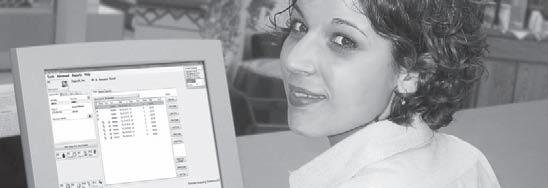

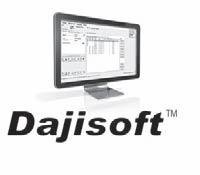
Our excellent service commitment to you does not end with your purchase. We are always there to help you whenever you need us. Just pick up the phone and call us on our Technical Support line.



Call us about our new version of Uniform Tracker
Members of the Michigan Insti tute of Laundry & Drycleaning (MILD) will celebrate the organiza tion’s 100th anniversary during its 2013 Summer Convention, scheduled for July 26-28 at the Grand Hotel on Mack inac Island, Mich.
For more information about this spe cial event, call the Institute’s office at 877-390-6453.
The Beijing China International Exhibition Center will play host to the 2013 China International Laundry and Cleaning Exhibition on Aug. 8-10.
The event will showcase the latest technologies, machines, apparatus and chemicals for laundry, dry cleaning, stain removal, ironing, dyeing and dis infecting, organizers say.
Exhibiting brands come from more than a dozen countries, including the United States. Laundry Expo 2012 had some 500 booths covering more than 10,000 square meters. This year’s event is expected to feature 800 booths on more than 15,000 square meters.
To learn more about Laundry Expo 2013, visit the show’s website at laundryexpo.cn/EN/main/index.asp.
TRSA’s Annual Conference & Ex hibits format features educational sessions and networking for all levels of management in textile service com panies. The event provides updates on the latest trends and practices in the uni form and linen supply business.
The Fairmont Sonoma Mission Inn & Spa in Sonoma, Calif., will host this year’s event on Sept. 22-24.
Sessions appeal to local and region al independent operators and national companies, covering hot-button topics in hospitality, industrial and healthcare markets. Seminars are scheduled con currently to enable attendees to partici pate in those most applicable to their professions and market specialties.
The Annual Conference is open to all laundry operators—TRSA mem bers and non-members. It combines elements of three previous TRSA meet ing formats—the Annual Convention, Leadership Conference and Healthcare/ Tech-Plant Conferences—with sessions for senior management and plant opera tions.
To learn more, visit trsa.org. O
American Drycleaner, March 2013 www.americandrycleaner.com
March 7 Minnesota Dry Cleaners Asso ciation Training Seminars and Annual Meet ing. To be held in Bloomington, Minn. Visit minnesotadrycleaners.org for more infor mation.
March 9 Dry Cleaning Alternatives Summit and Trade Fair. To be held in Denver. Call 303-692-3175 or e-mail joni.canterbury@ state.co.us for more information.
March 15-16 Wisconsin Fabricare In stitute Drycleaners Annual Convention, Auction and Trade Show. To be held in Pewaukee, Wis. Call 414-529-4707 or e-mail bswingle@toriiphillips.com for more information.
March 15-17 Southwest Dryclean ers Association Spring Showcase. To be held in Dallas. E-mail staff@sdadryclean.com for more information.
June 20-22 Clean Show: World Educa tional Congress for Laundering and Dry cleaning. To be held in New Orleans. Visit cleanshow.com for more information.
July 31-Aug. 3 Textile Care Allied Trades Association Annual Management and Edu cational Conference. To be held in San Diego. Call 973-244-1790 for more infor mation.
Sept. 22-25 Textile Rental Services As sociation Annual Conference. To be held in Sonoma, Calif. Call 703-519-0029 for more information.
Oct. 19-20 NCA Texcare Trade Show & Exhibit. To be held in Secaucus, N.J. Call 212-967-3002. O
(Photo: © iStockphoto/ivanastar)

Dry
www.americandrycleaner.com
American Drycleaner, March 2013

In the continual quest for more sales and profit, invariably the subject of diversification arises. Diversification discussions usually include the topic of disaster restoration, so it might be appropriate to explore the reasoning behind a major effort to diversify and particularly to expand in the arena of disaster restoration services.
Diversification into any new business is a serious commitment, but restoration may require even more exploration than other related businesses. The large potential orders are alluring, the processing sounds easy, and the volume can help utilize excess capacity.
It is normal to have this driving incentive to increase sales volume, which is absolutely legitimate with a few caveats. I’ll attempt to list considerations to ponder before deciding to capitalize on this potentially lucrative source of business.

reas O ns FO r CO nsi D ering D iV ersi FiCati On. Maximization of market potential is a driving consideration if the potential is examined in its entirety. Both sales volume and resulting profit should be explored thoroughly. Many
To find past Management Strategies columns or share this month’s with your friends, visit AmericanDrycleaner.com.
times, sales stories have been shared that on the surface look tremendously exciting, but the retroactive profitability analysis shows extremely disappointing results. You have all heard the initial excitement of the Groupon wave that was often later followed by the exclamation, “Never again!” Sales are exciting but ultimate profit is what really counts.
Maximization of return on assets also drives the diversification decision: “I have all this capacity that should be utilized.” Remember that filling a plant doesn’t fill a bank account. But if there is profitable utilization of that capacity, the rewards can be dramatic. Life cycle of company ownership is another consideration for diversification. If near-term retirement is the goal, a new division will probably push that plan further into the future, even though it could better provide for the eventual retirement. If the business has been newly acquired or is in growth mode, additional lines of business may be a necessity to meet the sales and profit goals for growth.
Succession planning can also be a good reason for adding restoration to your operation. If the next generation (or other potential future owner) is ready to join the enterprise team, the new venture may be an appropriate place to utilize their skills.
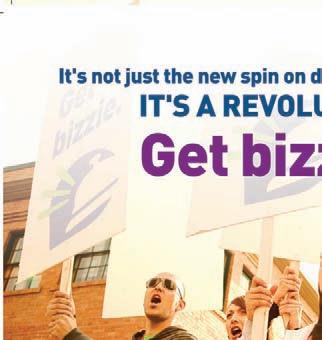
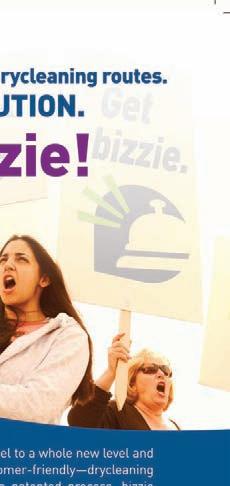
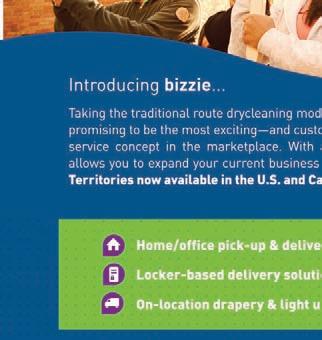
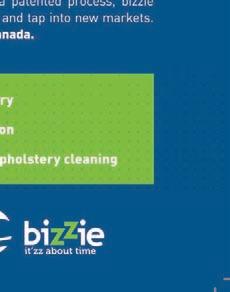

STEPS TO MAKING THE RESTORATION DECISION.
Estimate the potential in your market first before anything else. If the market potential doesn’t exist, every other issue on the list is academic. So consider:
Total population numbers, density and lifestyle breakdown all contribute to the success of restoration operations. The population must be sufficient and appropriate to support your efforts.
A climate conducive to fire incidents is beneficial to predicting restoration potential due to furnace puff-backs and heating seasonality.
Non-fire disasters such as hurricanes, tornadoes and flooding, although seemingly more common, are regional and definitely not as predictable. The number of and expertise of competitors is also critical to this decision. This is an aggressive, competitive business where networks and contacts are crucial.
CHECKLIST OF CREDENTIALS. Once you have determined the potential for restoration business in your market and decided there is a profitable share for you to capture, consider your credentials for competing effectively:
The ability to manage multiple diverse operations is essential to the success of any new endeavor, especially to a venture into the disaster restoration arena. A restoration operation is not traditional dry cleaning as usual.
The ability to fund a major division creation and expansion is also key to the success of this enterprise. This is not an overnight solution to increased sales and profit. A substantial initial
investment is required for:
1. Dedicated management to direct the division (even if it is initially parttime), understand the business and manage the effort.
2. Infrastructure above unused plant capacity. Major sorting, marking, storage and, frequently, a drying room and deodorizing facilities are needed as well.
3. A dedicated, effective, professional business-to-business sales effort, which is probably the most common success factor in this business. It is expensive during the building phase when there are no initial sales coming in.
The ability to weather uncertain cash flow is probably the most challenging issue to owners. It is important to remember that:
1. Disasters are unpredictable.
2. Victims are often unpredictable and emotional. They may prefer the cash offered by the insurance company after you have done all the preliminary work, so don’t work on or count on the job income without an agreement from the victim and/or the insurance company. Middlemen, such as contractors, are not the ultimate decision makers.
3. Insurance companies are not individuals. Don’t rely completely on your contact’s information.
4. Collections are key. It is important to understand the aspects of this business that can cause delays in collections, such as waiting for permits to rebuild or scheduling contractors and/or their subcontractors. Also, major corporations such as insurance
American Drycleaner, March 2013 www.americandrycleaner.com
companies aggressively manage their accounts payable and so you must aggressively manage your accounts receivable to collect. You must pay your labor and expenses early, so deposits and clear payment releases need to be negotiated and clarified. Access to a flexible workforce is essential due to the unpredictable nature of this business and the immediacy of the response when this work does materialize. The ability to respond on the schedule of the victim and/or their insurer is vital to the success of the current job as well as future referrals. Rest assured that the next provider is on their call list.
An around-the-clock monitoring mentality is critical due to the immediacy of the response required to service the work. Disasters aren’t confined to normal business hours. Showing empathy for victims helps during an extremely stressful life event for your insurance company client or its customer.
TO AFFILIATE OR NOT TO AFFILIATE. It is likely that if there is significant restoration business to be done in your market, there is already one or more franchisees and/or restoration association members covering your area. But you may be considering the opportunity to affiliate due to an acquisition or an additional offering becoming available. Even seasoned restoration operations have found good reasons to affiliate, finding that the benefits outweigh the associated costs and restrictions. Some of them are:
National recognition Network contacts
www.americandrycleaner.com
Management training and support Production, tracking and billing systems and procedures
Marketing expertise
SHORT-TERM ROI VS. LONG-TERM ROI. The most telling analysis in determining if the restoration business is appropriate for your expansion goal is to weigh the short-term return on investment (ROI)—which may likely be negative—against the probable long-term ROI.
This is challenging because the up-front investment in infrastructure, management, sales effort and training is significant and
A restoration operation is not traditional dry cleaning as usual.
there is no guarantee that the long-term return will be sufficient or consistent. (Imagine the impact of Hurricane Sandy in one year vs. a no-disaster year the next.)
Disaster restoration can be a good addition to your offerings, but it is not for the casual participant, the faint of heart, the timid, or the business unable to fund the operations and fluctuations resulting from the uncertainty of volume and profit flow.
If you have the cash for investment, the dedication to make it profitable, the sales effort to combat brutal competition, and the fiscal stamina to focus on the long term, then it may be the right path for you and your company. O
Methods for Management (MFM) Inc. has served the dry cleaning and laundry industries with afford able management expertise for improved profit ability since 1953. For assistance with restoration services or investigating expansion into this busi ness, contact Diana Vollmer at dvollmer@mfmi. com, 415-577-6544.
American Drycleaner, March 2013
Iam hoping we have turned the corner on the “casual workplace” trend and will begin to see an increase in the number of neckties to be cleaned. Much like the rebirth of natural fibers 25 years ago, many cleaners have little experience in the proper cleaning and finishing of a necktie.
Men have an emotional attachment to their ties. Favorite ties are worn until the edges and knot areas are threadbare. I am guilty of having more than 50 ties, but I wear one from the same eight or 10 on most occasions. My red tie with diamond shapes of royal blue and silver has been retired but still brings back memories of my first consulting job.
Cleaning a necktie is as much art as it is skill. It involves knowing more about what not to do than about aggressive techniques. Ties are not cheap. Polyester ties often sell at between $20 and $50; a good silk tie may sell for around $140. At the point where emotion and investment meet, the cleaner can easily find a profitable item.
Ties have a combination of unique characteristics. The material is cut on an angle (the bias), which makes it easier to construct the narrow end in relation to the broad end. Cutting on the bias also makes it easier to tie the

necktie. Those pretty diagonal stripes are the product of cutting the material on the bias. But cutting the fabric on the bias also creates problems for those attempting to clean a tie.
Ties are dimensionally unstable and are prone to distortion of the design and yarn slippage, which can easily happen during stain removal. When spotting a tie, it is a good idea to reduce the normal work area by half to limit the risk of damaging the tie.
Ties come to the dry cleaner with obvious stains; they tend to function as a bib when the wearer is eating. You can expect to find a stain in the body of the tie and body oils in the area where the tie was knotted.
When food is dropped on the tie, the temptation of the water glass and napkin is too strong for some people. They dip the napkin in the water and briskly rub the stain. In most cases, the tie is chafed, leaving a light area. The spotter using aggressive mechanical action, especially on silk, makes the same mistake. Since most ties are silk and cut on the bias, ties require a delicate touch.
First, do no harm. Commercial silk restorer or mineral oil on a powder puff or in a dip bath will usually mask the chafing damage. Your CSR should inspect ties well for picks, yarn slippage, fraying and chafing when

received from the customer.
Pre-spot ties on the dry side with a general pre-spotter or leveling agent. There should be no moisture, which means no use of a spray spotter. Run the ties in a net bag and on a short cycle to reduce mechanical action. Dry the ties, while still in the bag, at a reduced temperature. Immediately remove the ties from the bag once dry and hang them over a strut hanger.
If it is necessary to spot a tie on the wet side, remember that 1) silk bleeds and becomes much weaker when exposed to water and 2) bias construction is subject to yarn slippage and distortion by the pressure exerted by the steam and air coming from the spotting gun. Place the tie over a white towel on the spotting board and mist an area on the small end of the tie to determine how much the dye will shift when exposed to water. You can deal with a little dye migration by immediately drying the area after using steam.
Almost all of the stains left behind after dry cleaning will be water-soluble. The amount of post-spotting that can be done safely will depend on the extent the tie bleeds upon steam application. Reduce the work area to approximately one-half your norm and dry the area as quickly as possible after the application of stain remover and steam. Restrict mechanical action to tamping, as brushing and the bone/spatula increase the risk of distorting the fabric.
Follow the wet-side stain-removal protocol strictly; use alkaline stain-removal agents only after NSD and tannin have failed. Increase the distance between the steam gun and the tie to reduce fabricdistortion risk; do not bring it closer in an attempt to dry it more quickly. A tie has multiple layers, so be patient when drying

the treated area. But insufficient drying may lead to dye migration. After drying, apply a leveling agent as insurance against rings and dye migration. Hang the tie aside for at least a half-hour, then re-clean.
Never bring down the head of the press when finishing a tie, as this will crease the outside edges. A majority of ties will require only a light application of steam.
Lay the tie on the buck of the press, with the tie’s “face” against the padding. Apply steam for roughly five to eight seconds. Press the vacuum to remove the moisture and cool the tie. If wrinkles remain, remove them using a horsehair brush with steam. For tough wrinkles, use steam and a hand pad.
Do not use an iron on the tie against the pad. Hold the tie in the air with one hand while applying steam from the iron to the fabric with the other; be careful to keep the steam well below your top hand to avoid getting burned. It is worthwhile to have a tie form for cases when normal procedures prove inadequate.
The ability to clean and finish ties well is the sign of a good cleaner. O
Martin L. Young Jr. has been an industry consultant and trainer for almost 20 years, and a member of various stakeholder groups on environmental issues. He grew up in his parents’ plant in Con cord, N.C., Young Cleaners, which he operates to this day. Contact him by phone at 704-786-3011, e-mail mayoung@vnet.net.
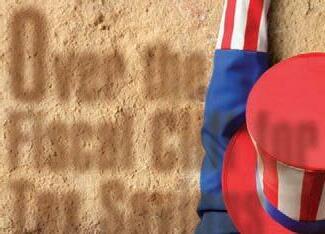
 By Mark E. Battersby
By Mark E. Battersby
good news and bad news for dry cleaning businesses
The so-called “fiscal cliff” tax package recently signed into law renewed more than 50 temporary tax breaks through 2013, saving individuals and businesses an estimated $76 billion. For the owners and operators of small- and medium-sized dry cleaning businesses, there is good news and bad news contained in the fiscal cliff tax laws.
First, the good news: greater certainty in taxes. The owners and operators of dry cleaning businesses have grown used to many longstanding tax breaks but they also have had to get used to the uncertainty of whether they will be renewed each year.
On the downside, in addition to a 3.8%
Net Investment Income (NII) tax and a 0.9% Additional Medicare tax that, thanks to the Health Care and Education Reconciliation Act of 2010, began in 2013, many dry cleaners and laundry owners discovered they are subject to new taxes. Single individuals with incomes above the $400,000 level and married couples with income higher than $450,000 will pay more in taxes in 2013.
TIONS. The American Taxpayer Relief Act extended through 2013 the Tax Code’s Section 179 first-year expensing writeoff for equipment and business prop-

erty purchases. Now, the higher expensing limits in effect in 2011 have been reinstated for 2012 and extended for expenditures made before Dec. 31, 2013. Thus, a dry cleaning business can expense or immediately deduct up to $500,000 of expenditures in 2012 and 2013, subject to a phase-out if total capital expenditures exceed $2 million.
The election to expense the off-the-shelf computer software used by so many dry cleaners under Section 179 has also been extended and applies to expenditures made before Dec. 31, 2013.
While 100% “bonus” depreciation expired at the end of 2011, today the new law allows 50% bonus depreciation for property placed in service through 2013.
standard MACRS (Modified Accelerated Cost Recovery System) and have a recovery period of less than 20 years. Section 179 first-year expensing remains a viable alternative, especially for small businesses. Property qualifying for the Section 179 write-off may be either used or new, in contrast to the bonus depreciation requirement that the taxpayer be the “first to use.”
The tax break that allows profitable dry cleaning businesses to write off large capital expenditures immediately—rather than over time—has long been used as an economic stimulus by our lawmakers. While 100% “bonus” depreciation expired at the end of 2011, today the new law allows 50% bonus depreciation for property placed in service through 2013.
Some transportation and longer-lived property are even eligible for bonus depreciation through 2014. If bonus depreciation had not been extended, the 2012 tax year would have been the final year in which substantial first-year write-offs for buyers of business automobiles and light trucks were available.
To be eligible for bonus depreciation, property must be depreciable under the
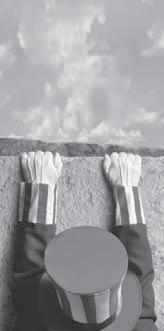
Leasehold improvements and building improvements generally must be depreciated over 39 years. The tax law provides a special 15year, straight-line depreciation break for qualified leasehold improvements, restaurant property, and retail improvements. Naturally, there are quite a few restrictions, such as the lease must between unrelated parties. Qualified leasehold improvements also qualify for the 50% bonus depreciation. In fact, qualified leasehold improvements, restaurant property, and retail improvements up to $250,000 may qualify for Section 179 expensing. And, best of all, these provisions have been extended for property placed in service before Jan. 1, 2014.
MORE, MORE AND MORE. The Work Opportunity Tax Credit (WOTC), which rewards employers that hire individuals from certain target groups, has extended to Dec. 31, 2013, and applies to individuals who begin work for the employer after Dec. 31, 2011. Under the revised WOTC, dry
American Drycleaner, March 2013 www.americandrycleaner.com
cleaning businesses hiring an individual from within a target group are eligible for a credit generally equal to 40% of firstyear wages up to $6,000.
An S corporation is a pass-through entity and not usually subject to income taxes. It is, however, liable for the tax imposed on built-in gains or capital gains. The tax on built-in gains is a corporatelevel tax on S corporations that dispose of assets that appreciated in value during the years when the operation was a regular C corporation.
The new law extends a relaxed version of the provision limiting the “recognition period” to five years, but only for “built-in gains” recognized in 2012 and 2013. Thus, if a dry cleaning business elected S corporation status beginning Jan. 1, 2007, it will be able to sell appreciated assets it held on that date without begin subject to a hefty tax bill.
TAXING IT ALONE. As mentioned, single individuals with incomes above the $400,000 level and married couples with income higher than $450,000 will pay more in taxes in 2013 because of a higher 39.6% income tax rate and a 20% maximum capital gains tax. Of course, for other individuals, the alternative minimum tax (AMT) has finally been indexed for inflation.
Ironically, the AMT was created to ensure that wealthy individuals, not middleincome households, would pay some kind of income tax. The new law increases the 2012 exemption amounts to $50,600 for unmarried individuals and $78,750 for couples filing jointly. For 2013, the AMT exemption amounts are predicted to be $80,750 for married couples filing jointly and $51,900 for single individuals.
ESTATE TAXES NEVER DIE. Always of significant interest to family-owned businesses, the estate tax has long been a bit of a mixed bag. The $5 million-per-person exemption was kept in place (and indexed for inflation). The top rate was increased, however, to 40% effective Jan. 1, 2013. This change is expected to increase government revenues from 2012 levels by $19 billion. Other good news for estate planning: portability is kept in place and estate and gift taxes remain unified, i.e., the $5 million stays in place for gift-tax purposes as well as estates. And, best of all, it is all permanent.
Good news for estate planning: portability is kept in place and estate and gift taxes remain unified.
PLANNING OPPORTUNITIES ABOUND. The majority of dry cleaning businesses operate as pass-through entities, such as partnerships and S corporations. Profits are passed through to their individual owners and therefore are taxed at individual income tax rates. Some business owners might be considering switching to a regular C corporation with its top rate of 35% rather than doing business through an S corporation, LLC, etc., subject to a top rate of 39.6% on the pass-through income.
But it’s important to look much deeper than the tax rates. With a pass-through entity, the shareholders are taxed only once on the income. With a regular C corporation, distributions would first be taxed at the corporate level and once again at the shareholder’s level for an additional 15-20%, plus the 3.8% net investment income tax.
American Drycleaner,
That double taxation becomes even more significant on the sale of the dry cleaning business. Although there are provisions in the tax law that allow all or a portion of the gain on the sale of a business to be excluded or ignored, they are limited.
Many popular but temporary tax extenders relating to businesses were included in the American Taxpayer Relief Act.

Another consideration, particularly for small businesses, is that any expenses disallowed by an IRS auditor will only result in increased income to the pass-through entity. When doing business as a regular corporation, disallowed personal expenses increase the income of the corporation and are taxed as constructive dividends to the shareholders. The same is true for unreasonable compensation of shareholder/officers.
Keep in mind that if a switch from an S corporation to a regular C corporation is made, a switch back to an S corporation can’t be made for five years—unless permission is received from the IRS. If an LLC or partnership is incorporated, there can be expenses and potential tax consequences.
The increase in the top tax rates, the AMT relief provided for the 2012 tax year, and the hidden taxes all combine to make it possible for many small- and mediumsized businesses ineligible for business credits thanks to AMT limitations in 2011 to potentially be able to take advantage of these dozens of credits. It is, in essence, a back-door opportunity for small busi-
nesses, similar to when Congress expanded eligibility for credits for 2010. Although it is not the grand bargain as envisioned by lawmakers, many popular but temporary tax extenders relating to businesses were included in the American Taxpayer Relief Act: the Code Section 179 smallbusiness expensing, bonus depreciation, and the Work Opportunity Tax Credit. Unfortunately, the new law is effectively a stopgap measure designed expressly to prevent the onus of the expiration of the Bush-era tax cuts from falling on middle-income taxpayers. Congress must still address spending cuts and may even tackle tax “reform.”
The time is now—before filing the dry cleaning operation’s 2012 tax returns—for every dry cleaning business owner, operator and manager to consult with their accountants and/or tax professionals to focus on the potential savings offered by these newly revised, extended and expanded business credits, deductions and tax writeoffs. O
Information in this article is provided for education al and reference purposes only. It is not intended to provide specific advice or individual recom mendations. Consult a financial adviser for advice regarding your particular situation.
Mark E. Battersby is a freelance writer who has specialized in taxes and finance for more than 25 years. He is based in Ardmore, Pa.
American Drycleaner, March 2013 www.americandrycleaner.com
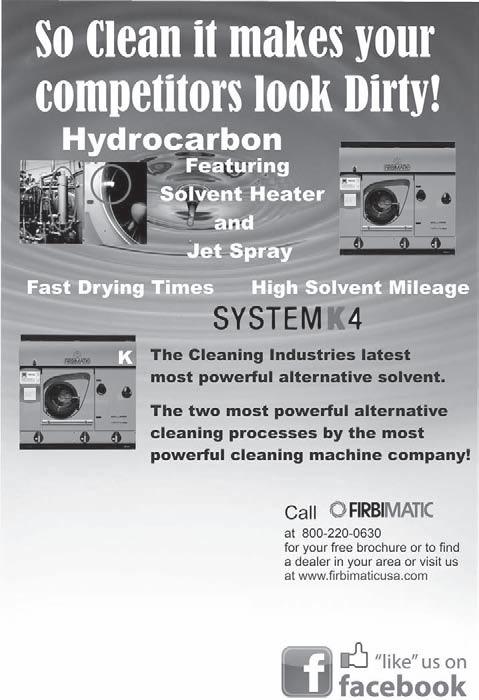


Global Business Systems’ (GBS) SortingRobo is an automatic assembly machine designed to save time and money in the assembly process. The SortingRobo can be integrated easily with any dry cleaning point-of-sale (POS) computer system and is suitable for wholesale, hotel and route work, and for any size of dry cleaning plant, GBS says.
The machine works to minimize human error and can save up to 75% on labor costs in the tagging and assembly process, GBS says. SortingRobo can tack all gar ments, as well as assemble orders auto
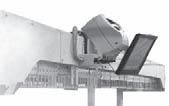
matically with 100% accuracy using perma nent bar-code tags. SortingRobo can handle up to 2,000 pieces per day, GBS adds. smart4me.com | 800-717-2507
<<
DryClean PRO is a Windows-based point-of-sale software system that can be installed in a range of stores, includ ing full-price and discount cleaners, small pickup stations, large megastores, and single- and multiple-location franchises, Dajisoft Inc. says. It takes care of every problem, from managerial paperwork to lost-garment headaches, the company says, and most users can be trained in a couple of hours.
DryClean Pro has built-in multiple-store connectivity to provide updates on store progress, and connects to a dry cleaner’s website. It also allows permanent tagging to save labor hours, and offers built-in marketing reports. dajisoft.com | 888-325-4763
The Enlite POS system by ScanQ offers simplicity, efficiency and security, the company says. It takes cleaners and their employees less than 20 minutes to learn how to use the system.
A menu screen can be edited to meet the user’s needs and make every transaction more efficient. Enlite offers a wide range of reports for marketing, accounting, and employee activity that will increase revenue, help establish better relationships with customers, and prevent employee theft, ScanQ says.
Its software also features heat-seal technology, billing services, master accounts, multistore management, garment management services and more. These features were created to work together with complete operational automation, ScanQ says.
ScanQ invites cleaners to try out its software before buying. It’s available for download at its company website.
scanq.com | 678-240-9090
American Drycleaner, March 2013 www.americandrycleaner.com
The eAnytime mobile Professional Cleaning Service DropOff™ & PickUp™ station is an alternative to a staffed drop store and multistop pick-up and delivery route, the company says.
The point-of-sale station has increased capacity, is constructed of stainless steel, and has hidden lockable wheels for ease in posi tioning in a supermarket, office building, apartment building or large employer. The station addresses dry cleaning and other operations, and branding, pricing, service schedule and contact information are all customized to the dry cleaner.
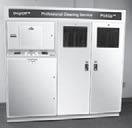
Customers select items, enter quantity and special instructions, and choose the day they would like to pick up their order from the PickUp™, which houses up to 60 orders on computer-controlled, individually locked, five-hanger-capacity hanging positions. The cus tomer pays via wireless Internet at the station with a credit or debit card upon depositing an order in the DropOff™. This is also used to send e-mail alerts, and for the cleaner and the company’s support team to interact with the station.
eanytime.com | 714-969-7000

Fabricare Manager POS is a user-friendly touchscreen system with features for any size of operation, big or small. The sys tem recently was enhanced with new capabilities that make it easier and faster to use, the company says. New features include category e-mail addressing, enhanced customer profile management, and new management logging and tracking reports.
E-mail messages now can be sent for any one customer to any number of e-mail or text addresses in five separate message categories.
Other enhancements include a new customer-profile screen featuring more security and configuration options, easier training steps, and quicker data access. New transaction and audit reports can be run directly from the profile screen, secured as viewable or hidden for each employee.
fabricaremanager.com | 770-924-6580
www.americandrycleaner.com
The latest version of Compassmax, Maineline’s com plete computer system, includes auto-assembly integration and an assisted-assembly module that allows users to assemble orders easily. Compassmax also features an improved graphical inter face, including touchscreen options that make the software easier to use.
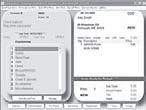
An online information center lets custom ers check account balances, build profiles, make payments, schedule pickups and more. A Pieces Per Operator Hour (PPOH) module helps owners manage employee ef ficiency; they can also design reports using a custom reporting tool. An optional pocket PC can be used for drive-thru operations, racking and route scanning, and new screens can be personalized for individual reporting needs. Improved e-mail templates can personalize e-mails sent to individual customers.
compassmax.com | 800-354-2525
American Drycleaner, March 2013
<<
Version 6.4 of Cleaners PROFITMaker, a point-of-sale system from Personal Touch Systems, offers ease of use and speedy order processing, making it a quick way of entering garments into a dry cleaning soft ware system, the company says.
The QuickDrop feature allows the entry of garments into an order pro cess with a single touch or mouse click. The custom izable screen defines garments in order of preference so the most-often-dropped garments are ordered at the top on a single screen for fast and easy mark-in.
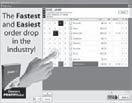
Free data conversion makes upgrading to Cleaners PROFITMaker easy, the com pany says.
profitmaker.com | 800-950-6767
Computer Connections’ WinCleaners leads the way in management systems, the company says. The system is designed with touch screens and incorporates the latest technologies into an easy-to-use interface to help simplify running a business.
Dry cleaners can customize WinCleaners to suit their needs, with more than 270 options, including neighbor search, multiple-store man agement, web-based customer order track ing, unattended auto mated assembly for most major conveyor manufacturers, credit card processing, routes, receivables, hotel management and more.
wincleaners.com | 800-684-6650
The CleanSuite program offers dry cleaners regular point-of-sale functionality as well as inventory, customer account and staff control, its developer says.

The system handles credit cards, routes, hotels, auto-assembly, accounts receivable and statements, and the operator can use either the touch screen or the keyboard.
A business building section helps a store owner grow the business, and allows contact with cus tomers by e-mail, SMS, phone or snail mail.
CleanSuite of fers 24/7 support, with no ongoing yearly contracts.
A full, working copy of the software is available to test free for the first 100 invoices.
cleansuite.com | 888-727-4564
Touch Control v5 is the latest point-of-sale software from Liberty Computer Systems.


Version 5 has advanced features such as an iDryClean mobile ap plication available to both iPhone and Android phone users. This app al lows custom ers to easily check on the status of their dry cleaning order, the company says.
The system also will e-mail or text the customer regarding pick-up after an order is finished and racked on the dry cleaner’s conveyor.
libertycomputers.com | 800-233-9804
American Drycleaner, March 2013 www.americandrycleaner.com









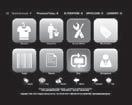
Cleaner Business Systems point-of-sale software was designed to work with any size and type of dry cleaning operation. Features include an employee time clock, detailed report ing, a precision lot-management system, and the ability to integrate with major assembly conveyors.

The CBS Back Office software works well for a single store or for multiple stores, the company says, allowing owners and managers to access the store or stores from an office, home office, or anywhere with an Internet connection.
With CBS, e-mail marketing, automatic e-mail notifications, coupon tracking, and customer rewards programs are all in one software package.
CBS also is able to track employee activities or track down employee theft, and a support technician is available to answer any questions or help with any issues, the company says.
cleanerbusiness.com | 800-406-9649
<<
Comca Systems offers Mobile Point of Sale for Android tablets, and an iPhone/Android application for dry cleaning customers.
The Mobile POS for Android tablets is a feature-rich application that allows dry cleaners the opportunity to count pieces, view customers’ orders, keep track of starch levels, and generate a “Fast Ticket” with ready date, the company says.
The application prints to a printer or sends a receipt via e-mail. Employees can cash out invoices accepting cash, checks or credit cards. The tablet can replace a computer on the front counter if used only for drop-offs and pick-ups, the company says.
The iPhone/Android app allows customers to check orders and request pick-ups. It also gives dry cleaners options to send promotions directly to customers; it lists all store locations with phones and e-mails. comcasystems.com | 813-996-5922

Computer Systems International (CSI) develops point-of-sale software suites as well as backoffice, wireless, web, and enterprise software suites.
The company offers the Textile Management System for dry cleaning operations and other operations. TMS can be obtained as standalone software for a small operation, or it can be used in a cloud-host ed environment. An SQL Hosting subscrip tion is an alternative to purchasing the software license.
A recent CSI of fering is iAssemble, a 64-bit application with the latest Microsoft technology. It is integrated with an assembly conveyor, or a dry cleaner can use existing racks. iAssemble provides efficient, automated order processing on the assembly conveyor or rack, eliminating the need for manually matching each garment with the corresponding invoice, the company says.
The system provides improved customer ser vice by increasing order accuracy, CSI adds. computersystemsint.com | 888-836-7274
American Drycleaner, March 2013 www.americandrycleaner.com
CleanTouch from Easy Plus Inc. is designed for people who have never before used a computer, the company says. Most us ers learn how to create drop and pick-up invoices with less than 10 minutes of training. The simple design and ease of use are popular features, Easy Plus says, and users can customize Items, colors and up-charge buttons for easy entry.
From monthly account customers to delivery customers, CleanTouch allows owners or managers of dry cleaners to easily manage their stores. The system also moni tors suspicious activities with an advanced feature, “MoneyGuard.”
CleanTouch’s marketing feature allows users to create mails, e-mails and coupons to designated customers. It also sends text messages to customers to notify them when garments are ready to be picked up. easyplusinc.com | 877-248-3684


SPOT Business Systems offers software with hundreds of user-friendly features, including customer-retention marketing, internal messaging with e-mail forwarding, enhanced customer-relationship manager (CRM), restoration scheduling calendar, full credit card PCI certification, new batch mark-in for heat seal label (HSL) process ing, enhanced SPOT-based Assisted Garment Assembly for improved ef ficiency, and interfaces to Metalprogetti, HMC, and White Con veyors auto-assembly conveyors.
New features include MyDryCleaner Mo bile consumer app for iPhone and Android devices, a redesigned RouteTrac Mobile route management system, redesigned ProductionTrac plant garment management with integrated PPOH functionality, and the new SPOT Dashboard.
spotpos.com | 801-495-1200

Recently re-engineered, Dry Cleaning Computer System’s CA SORT is a point-of-sale Windows-based automated assisted-assembly system.
CA SORT plugs into an existing DCCS system without modifications to the assembly area. Its small footprint design lends itself to tight spaces, and the efficiencies, accuracies and speed of sorting orders surpass any manual method, DCCS says. The system supports bar-coded paper tags, heat seals or radio-frequency identification, and it can handle around 100 orders per hour.
The software applications and products include automated ticket writing, cash and in ventory control, accounts receivables, routes, hotel/valet, PCI-compliant credit cards, and customer retention/marketing, as well as production and management reporting, employee productivity analysis, e-mail/text messaging, customer relationship manager, multi-store enterprise software, and a permanent bar-code, heat-seal and interface software to Metal progetti, HMC, Iowa Techniques, and White conveyors and 24-hour kiosks. dccs.com | 610-275-6090
www.americandrycleaner.com
American Drycleaner, March 2013 31
When disaster strikes, the smart insurance adjuster calls in a dry cleaner that specializes in restoring garments and soft goods
By Bruce Beggs, Editorial DirectorAlate-night fire scorches a two-story home, but firefighters are able to douse the flames before the structure is destroyed. Still, the smoke and water damage is extensive. Now, in his time of greatest need, the homeowner turns to his insurance company to begin the process of getting his family’s lives back to normal.
So, who does the insurance provider turn to at a time like this? It’ll call in contractors to see about repairing and/or rebuilding the structure, but before that can
happen, something has to be done about the family’s personal belongings. Can they be saved? Are they worth saving?
That’s when the smart adjuster calls in a dry cleaner that specializes in restoring garments and soft goods. Long an offshoot of dry cleaning, restoration has come into its own as the add-on that can easily eclipse the core business.
When American Drycleaner last featured this niche market five years ago, it was written that “restoration is no longer a matter of saving a cherished wedding


gown or antique quilt—it’s about reclaiming any item still useful to the customer and cost-effective enough to rehabilitate for the insurer.”
Providing restoration services is about reclaiming any item still useful to the customer and cost-effective enough to rehabilitate for the insurer.
That still holds true today, plus the insurance industry’s increased awareness of restoration dry cleaning has led to more work for those businesses with the expertise to meet the needs of the homeowner and the insurance carrier during arguably the most trying of times.
VALUED RELATIONSHIPS. Launched in 2002, the Certified Restoration Drycleaning Network (CRDN) has grown to about 150 franchise operators in the United States, Canada and the United Kingdom. It generates revenues in excess of $100 million annually.
“We see the market continuing to expand,” says CRDN CEO Wayne Wudyka. “(Insurance) carriers are far more aware of the category and the value of a good textile restoration expert today more so that they ever were.”
Jim Nicholas is president of FRSTeam, a Hayward, Calif.-based franchiser of restoration services. His company has been selling franchises since 2005, and currently has 40 franchise locations and seven company stores throughout the United States.
“Insurance companies have identified the value of having a relationship with a textile restoration company, rather than have us be a tertiary contact or someone
that a contractor would just bring in,” he says. “There are more insurance companies that are looking at us as a specialty in and of ourselves, and a relationship that warrants more direct interaction.”
Nicholas sees more market segmentation along the national and regional fronts than there was five years ago. “There’s more established brands now. There are some marketplaces where, in some of the large urban areas, you can have between eight and 10 restoration dry cleaners all competing for the business in that market space.”
There are other franchises in the market, such as Evans Garment Restoration and TexCare, and there are independent restoration operators as well.
A group of independents, most of which are longtime family-owned and -operated businesses, comprise North American Restoration Dry Cleaners (NARD), an association led by Mark Folzenlogen, president of A-One Fabric Restoration in Cincinnati.
More and more cleaners have “flooded” the restoration market since retail dry cleaning sales began to dip amidst the weakened U.S. economy several years ago, according to Folzenlogen.
“There were a lot of people getting into the industry, and we were concerned that it was beginning to get a bad reputation,” he says. “You’ll find most of our members have been in the business a long time, so we’ve come up with best practices to try to offer the best possible answer for the longevity of this industry.”
LIFESAVER. What items are restoration dry cleaners able to save? Things like clothing, bedding, drapes, rugs, furs, stuffed ani-
American Drycleaner, March 2013 www.americandrycleaner.com
mals, shoes, and more. “A textile restoration expert can clean about 23% of what’s in a home,” Wudyka says. “If you took a house, turned it upside down and shook it, CRDN would pick up 23% of the items on the ground and restore those. That’s the largest single category of content items in a home.”
It’s estimated that restoration can save 80% over replacement costs on a typical insurance claim. For example, it could take $60 to replace a Tommy Hilfiger golf shirt, but only $5.75 to restore it. A $295 Ann Taylor dress may cost the insurer only $15.95 in restoration costs. That “saved” money can be applied to another part of the insured’s claim.
“Keep in mind that the homeowners have a limited amount of (contents) coverage in their homeowners policy,” Wudyka says. “The more they can save in our category, the more dollars they have available to use for things like electronics, appliances, jewelry, furniture, artwork, items that they would otherwise run out of coverage for.”
But the serious restoration dry cleaner better be prepared to respond quickly to a disaster site at any time of the day or night.
“Some time ago, that maybe would have been a differentiator, to go in and promise … to an insurance company or to a contractor” that your business offers 24-hour emergency service, odor removal, or some sophisticated inventory process, Nicholas says. “Now, those have become standard expectations for anybody who’s going to work in that space.”
And not every operation can handle jobs of this size. It takes capacity to clean so many items, and storage space to hold jobs until disaster victims have someplace
to put them.
“I’ve said this for 12 years, but cleaning is the easiest part of doing textile restoration for the insurance industry,” Wudyka says. “It’s all the other nuances that you have to be aware of, and take into account when you get into this business.”
“More accomplished cleaners can manage that part,” Nicholas says of the cleaning demands. “The challenge for somebody that hasn’t been in this space before is the transition of … actively marketing against other companies.”
The more money that can be saved by restoring garments and soft goods, the more insurance dollars available for electronics, furniture and the like.
And it’s an absolute must to make local contacts with the insurance companies and resident disaster restoration firms and work to develop those relationships or “you really won’t get any work,” he adds.
NARD members visit other members’ facilities and give “good, honest critiques” of each other’s processes, Folzenlogen says. “We zero in on every aspect of our members’ businesses so that we can constantly improve, and help each other improve. … You have to have the ability to change with time, and to stay on top of the program requirements that are out there for the industry.”
“Ten years ago, the (restoration) category didn’t really exist. Our biggest competitor 10 or 11 years ago was the Dumpster,” Wudyka says. “Today, it’s a highly sophisticated part of the claim process that needs to be respected and handled appropriately.” O
Ionce wrote an article titled Training Foreign-Born Hispanics for Supervisory Jobs in the Dry Cleaning Industry due to the need to teach the growing numbers of Latino first-level supervisors how to improve performance in the face of customer demands.
The article explained how dry cleaners could boost productivity and speed turnaround times by training Hispanic supervisors to adapt the traditional authoritarian Latino leadership style to a U.S. “best practices” mode of supervision. I also discussed the five key elements needed for effective training of Hispanic supervisors. Here are those elements, and the results of the training from six dry cleaners using this approach. Each had four to seven drop-off stores, for customer convenience, feeding their garments to a single central plant.
WORKING WITH RATHER THAN AGAINST THE NATURAL AUTHORITARIAN LEADERSHIP STYLE. While authoritarian supervision is typical in Spanish-speaking cultures, it is a major stumbling block for success here. Hispanic supervisors were shown how to adapt their traditional management style to one that is more acceptable to workers in America.
Typical Hispanic supervision often amounts to ordering people around (no back talk), as well as rewarding and punishing. Training taught supervisors to modify this ingrained concept of authority by instead acting like a respected teacher or father. Although regarded as authorities in traditional Latino cultures, these figures represent responsive “respected mother”type icons, guiding subordinates to do the “right thing” rather than ordering them to do so. This construct helped convince the supervisors that this approach did not
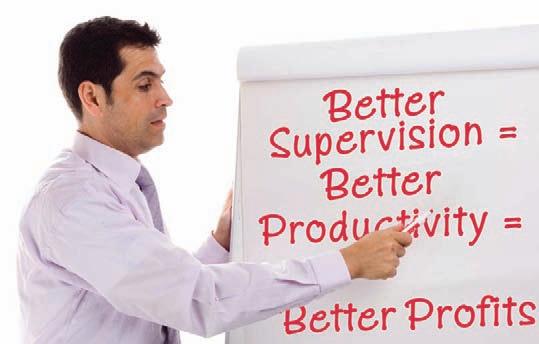
threaten their authority. They learned that one key to better productivity was helping, rather than just ordering, employees to improve productivity and quality.
One of the workers commented: “All of a sudden, my boss noticed how I was working, and even helped me straighten out a problem we were having with our spotting boards. I don’t know what happened, but since she started talking (to) us about our jobs, I enjoy coming to work a lot more. I try to get the garments spotted and ironed faster.”
The first lesson in training these supervisors, male or female, is to show them how to channel authoritarianism into a more constructive direction. Hispanic supervisors can accept their respect is enhanced, not diminished, by acting as constructive father- or mother-type figures. They learn that guiding employees is not a threat to their authority, but a way of engaging them in improving performance. The benefit of this approach was measured by departmental productivity, which climbed an average of 7% in this case. Absenteeism rates also declined, which helped turnaround times on the garments.
RATHER THAN SIMPLY GIVING ORDERS. Most supervisors are reluctant to ask for help. In Latin cultures, it’s a sign of weakness. Benefits of training increased when central plant floor superintendents were shown how to guide their subordinate Latino supervisors on a regular basis. Superintendent-supervisor meetings presented a strong “role model” to authoritative-style supervisors. If the floor superintendent or central plant manager could do it without losing face, so could they.
www.americandrycleaner.com
This guidance reinforced our training. Here’s what one supervisor had to say: “My boss never talked much to me. Would just hand me the list of re-dos. The other day, he told me individual meetings are a part of my training. So we sat down and went over the reasons for the re-dos, and he gave me suggestions on how to show the new girls the best way to iron and touch up. It worked out just like he said!”
These meetings resulted in fewer production delays and cut the re-dos as supervisors learned seeking guidance was not a sign of weakness. Improved managersupervisor communication trickled down; meetings between supervisors and their workers improved.
Face-to-face communications between plant management and individual supervisors is a must.
TRAINING NEEDS PLANT FLOOR EXAMPLES—NOT GENERALIZATIONS—FOR EFFECTIVENESS. Four of the dry cleaners had used inexpensive training sessions found on the Internet. The results showed supervisors couldn’t translate the generalizations of canned training to the specific problems in their own plants.
Before our training program began, our firm spent several days interviewing and observing plant employees — at the dry cleaning machines, in ironing, touch up, inspection and bagging. We wanted to uncover what workers needed from their supervisors for better performance, and how the workers perceived the guidance they were getting.
The typical worker in the pressing area, for example, wanted two things from supervision: help in solving on-the-job
American Drycleaner, March 2013
problems with their equipment, and ap proachable supervisors who did not denigrate them. These comments became mini-case studies for supervisors, who recognized them as issues from their own departments.
“I was surprised when I heard my workers were having problems with the spotting boards,” one supervisor said. “They had told me before, but I thought that was just an excuse. Now I see I should have been asking them and checking if their equipment was OK.”
“I found one [dry cleaning machine] was going only half as fast as the other, and was a bottleneck slowing up the department. I thought the operators were just goofing off. It showed me I’ve got to pay more attention to complaints.”
Training is more effective when supervisors understand the issues discussed are not theoretical examples from some book, but real-life problems from their own departments. When actual in-plant issues are used during training, supervisors realize it is no theoretical exercise but a way to help them deal with their problems.
The Latino supervisors’ natural tendency toward favoritism based on ethnicity and language was altered by teaching them to focus on goals encouraging teamwork. There was much less concern about language and cultural differences and much more cooperation when supervisors were taught how to reach specific goals. Here’s what a supervisor said:
“It was an eye-opener. I have a mixed group, some Spanish and some English. There was always this attitude that I give the Spanish speakers extra consideration
since we talked the same language. When we started concentrating on reaching daily goals, people were more willing to stop bickering and help each other, rather than asking for special consideration.
“With daily goals, we got a lot more teamwork since we were all working to the same thing. Some workers put pressure on others to keep moving and not fall behind.”
Setting specific department goals improved the sense of mutual responsibility among employees. Interestingly enough, being required to reach goals gave workers more of a sense of security than of fear. They knew where they stood.
“Other workers near me didn’t pass along any information from the supervisor,” said one worker. “I thought they were trying to make my life harder. When we had targets to achieve, though, people stopped fooling around, and we all got down to work. It made quite a difference in how much we put out.”
Goal-setting focuses supervisors, and their employees, on quantity and quality and reduces favoritism. The resulting cooperation in all six cases helped foreignborn supervisors to substantially improve their individual departments’ productivity.
CREATING A SENSE OF PRIDE BY SETTING BENCHMARKS. Productivity and quality performance was measured in each department before training started, and then several months later. This simple before-and-after comparison showed the Spanish-speaking supervisors the results of their efforts, and gave them a sense of pride in their accomplishments.
In each of the dry cleaners, supervisors’ production and re-do rates were reviewed with them before the training began, rais-
American Drycleaner, March 2013 www.americandrycleaner.com
ing awareness. Once they knew senior management was taking performance seriously, they realized they were being held accountable. They took the training to heart and focused on managing their departments to achieve better results.
“I never knew if my department (pressing) was doing better over the year or not,” one supervisor commented. “Our annual bonus is based on the amount of improvement, but there was nothing on record to go by. Now I know how I’m doing and can prove it. It gives me a tool to motivate my workers with.”
Make sure supervisors know their performance is being benchmarked. This becomes the basis for realistic goal-setting. Benchmarking underlies meaningful targets to shoot for, and training gives supervisors the tools to hit them. Having metrics available for supervisors to rate themselves
also helped improve productivity in all six dry cleaning plants.
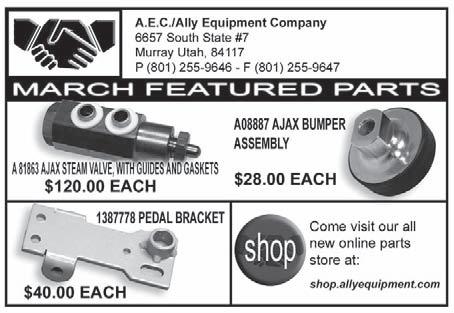
Although most consumers are not par ticularly price-conscious, they now expect next-day service on their garments along with excellent results. They also have fallen into the habit of expecting and using priceoff coupons. That hurts profit margins.
Given the uncertain times and high consumer expectations, dry cleaners face continued pressure for better productivity in order to cut per-unit costs while meeting customer demands for quality and nextday service.
What are you doing to achieve this? O
Mariah E. de Forest is vice president of Imberman and De Forest Inc., management consultants. For further information on results-focused supervisory training or productivity improvement in cleaning establishments with diverse workforces, she can be reached at 847-733-0071, info@IMBDEF.com.
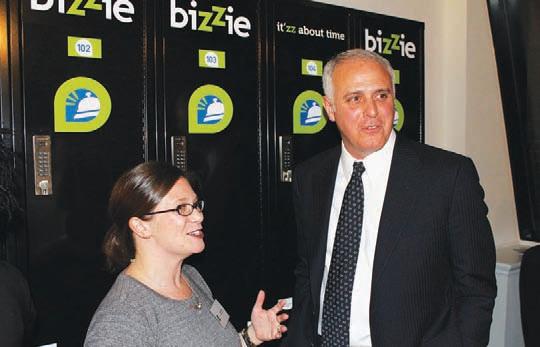 By Bruce Beggs
By Bruce Beggs
Wayne Wudyka, owner of 1-800-DryClean, has launched a new franchise brand—bizzie—which he believes will revolutionize the dry cleaning industry through patented technology and customer convenience.
The all-in-one cleaning solution combines state-of-the-art mobile technology with a convenient locker service. Its threepronged consumer platform offers home/ office laundry pickup and delivery, lockerbased delivery, and on-location cleaning for window treatments and upholstery to save busy consumers time.
The on-site lockers, or “bizzie boxes,” operate using smart phone technology and will be installed across the United States and Canada in office buildings, residential com-
munities, multifamily residences and parking structures, according to Wudyka.
Wudyka, through his Clean Brands LLC, owns and operates two dry cleaners in suburban Detroit, as well as the 1-800-DryClean franchise and the $100 million international brand Certified Restoration Drycleaning Network (CRDN).
He threw a launch party in January at Detroit’s Lofts @ Woodward Center, the first community to offer its residents the bizzie system. Customers who live there will lock their dirty garments in a “bizzie box” and text bizzie their box number to place their order. Once the dry cleaning is ready, bizzie will send a text containing a personalized PIN to enable the customer to retrieve the cleaned garments on their own schedule.
Carrie Cohen (left), property manager at the Lofts @ Woodward Center, greets dry cleaning entrepreneur Wayne Wudyka during his launch party for the bizzie all-in-one cleaning solution. Cohen’s Detroit property includes the first buildings in the nation to offer residents the bizzie locker-based dry cleaning delivery system seen behind them.

Tenant Crystal Coleman, who maintains a busy schedule as clinical director at a children’s outpatient mental health agency, is looking forward to taking advantage of the new service. “It’s the sheer convenience, and I love that it’s technology-driven.”
A company called The Laundry Locker founded the locker-based delivery system seven years ago, Wudyka says. “They are really an IT company that decided to get into the laundry business, and tried to define a better way of doing a very mundane task, with the use of technology,” he explains.
“Within four years, they became the largest dry cleaner in San Francisco, with no stores, through this locker solution.
“We took the strengths of their (business) model and matched it up with the core competencies of Clean Brands, which are franchising and developing businesses in the dry cleaning and textile industry, put together a strategic arrangement, and we’re launching.”
The 1-800-DryClean chain of cleaners, along with additional new bizzie franchises, will power the new service, according to Wudyka. Territories are available, he says.
The company is selectively targeting new dry cleaning franchisees, with a plan to expand the former 1-800-DryClean’s operator base from 100 to well over 400 franchises in the next few years.
“In a marketplace where the expense of building and opening a new store can be prohibitive, and where traditional route services can be difficult to grow, bizzie offers dry cleaning professionals the opportunity to diversify their businesses in a cost-effective manner,” Wudyka says. O
Sankosha USA is debuting the Cosmo Portable Spotting Board to the North American marketplace.
The Cosmo Spotting Board only uses electricity; no steam hook-up is required. It is easy to operate, Sankosha says, and its built-in turbo vacuum system plus an inverter ensures a faster, quicker process that prevents fabric damage.
Another unique feature of the machine is its portability, making live demonstrations possible.

“Sankosha has been a leader in providing innovative products to help our customers be more productive as well as profitable,” says Ken Uchikoshi, Sankosha USA president. He calls stain removal “one of the most important tasks for a cleaner to be successful.”
“Just like our pressing and bagging equipment, these revolutionary boards will be available through our very capable and excellent distribu tor network,” says General Manager Paul Choi.
The company remains committed to working with its trade partners to help the dry cleaning industry continue to grow, he adds.
sankosha-inc.com | 847-427-9120
Now available for its traditional line of coin dry ers, American Dryer Corp. (ADC) is introducing customizable dryer doors. Options include the laundry’s name etched into the door handles, as well as colored door rings.
A DC can laser-cut the laundry’s name into a metal bar across the door glass. This gives the store owner the opportunity to promote and help build branding, the company says.
Additionally, ADC is making available various color options for the door rings to further enhance the look and feel of individual laundries.
Door etching and ring colors are just two ways that ADC says it can help laundries stand out from the crowd.

amdry.com | 508-678-9000
American Drycleaner, March 2013 www.americandrycleaner.com
R.R. Street & Co. (Street’s) now offers two new products for the spotting board –PYRATEX® LV and WetDry™ Combination Spotter. Both products are formulat ed to be virtually odor-free, contain no halogenated ingredients, and provide efficient, effective stain removal, the company says.

PYRATEX® LV is designed for dry-side stain removal. Formu lated to take on heavy-duty stains, PYRATEX® LV can handle paint, oil, and grease stains (POGs), and even lipstick and cos metics, Street’s says.
The low-VOC (volatile organic compound) formula product has special soil suspension properties that help remove heavy dry-side stains and prevent stains like cosmetics, shoe polish, and others that contain dye from spreading, Street’s says.
WetDry™ combines dry-side and wet-side stain-removal agents all in one pre-mixed, low-odor product. It effectively removes a wide array of combination stains and flushes easily with water or steam, Street’s says.

The company adds that it’s ideal for “mystery” stains, eliminating wasted time and money resulting from trial-and-error spotting.

4streets.com | 800-4-STREET
www.americandrycleaner.com
American Drycleaner, January 2011 43 American Drycleaner, March
You don’t have to look far in this issue to realize the wide range of computer choices that cleaners have. Having more options is great. In many ways, the ability to choose allows you to find the best-fitting computer system.

But that same range of choices can easily be overwhelming, too. It contributes to the fear that you may choose the wrong computer. From a cost view, computers can take a sizable percentage of your total operating budget. A good choice will lead to where costs, compared to returns, are minimal. The gains you experience are far above whatever you paid.
Writing this column takes me back, I hate to admit, about 20 years. I was with a small company that focused on “contract programming.” This is back when most companies had what were called mini, or mainframe, computers. PCs were just coming out. There was no universally accepted operating system. Our company saw the gains that PCs were making, and that the day was coming when medium-sized and small companies would not need our programming support, source of our main income. So we looked at niche markets we considered to be under-
served and that could use our acquired experience (most of which was in manufacturing and inventory). We didn’t have much counter experience, but most computers then didn’t have a clue about how to set up and manage a two-step sale.
For the most part, shopping for and buying a counter computer system has not changed.
There are people (not me, for good or bad) who, before entering a grocery store, have their coupons ready and know the best route to get everything done as quickly as possible. They are far more prepared to spend a hundred dollars than you may be to spend $5,000 to $50,000 on a computer system.
Most cleaners go to a trade show or phone a company and when they get a salesperson, their first words are usually, “Well, whatcha got here?” Ironically, that is the same question they used on the system they hate today. If it didn’t work five years ago, why will it work now?
The guy who plans the complete route and knows the couponed items most likely gets in and out having everything he wants at a discount. The difference is planning.
Who do you want to be in control of deciding which system you buy: you or the salesperson? It will be the

salesperson if you start with “whatcha got” again.
I have no alliance with any computer company. But when I did, I would start with some flashy, mostly useless feature. You get home with your bag of brochures, lay them out on a table and try to remember which one had the horn sound every time the cash drawer was opened and which one had the cameras so you could see what was happening at the counter from your office. If you shop that way, you risk ending up with five more years of payments and a computer you don’t like.
If you are in business, most often the goal is to make the most profit in an industry you like, while running your business your way. There is absolutely nothing wrong with that. And as such, much of what I’ve written is with the idea that you are in charge.
To maintain that control, I suggest you follow dry cleaning pieces and laundry pieces as they are processed. There are some critical areas to analyze, with the first being the counter. Do you give a detailed receipt or a quick ticket? What would you like to do that you cannot today because your current system was not designed to handle it? At each step, write down what you have and, maybe more importantly, what you want. Identify the strengths and weaknesses in your current set-up.
Your computer at the counter is a customer’s first experience. Whether new or long-time regular, it is the first experience for them on this visit. I have always warned that the worst place to try saving a couple bucks is by shorting the counter stations. My example is the cleaner who sets up three stations with everything each
person needs, then provides one pen for all to share.
Track everything. If you skip a step, inevitably it will be the one that bites back the hardest. Study your mark-in and pricing: where it is done, all details of your options currently charged, or that you would like to.
Remember commercial accounts, routes, if you do restoration work. Are there permanent discounts or permanent upcharges? Can it support automatic assembly? Do you want to bar-code garments or rack locations?
It is possible to write a book on pricing and still miss some method. The important factor is knowing what you require.
Never underestimate the importance of support. A great support team can get you up and running quickly. One that takes days or weekends off can be a problem. When your computer is not running, you will take longer to enter tickets manually and you’ll open yourself up to theft and loss of pieces that a computerized system would normally catch.
I have one last, simple question: who is going to have a higher degree of success in finding the perfect system for their business? Will it be the cleaner who calls a computer company and asks, “Whatcha got?” Or will it be their competitor who calls the same computer company, sends a list of what they require in a system, and then asks, “How do you do this?” O
Howard Kaschyk is a consultant with The Market ing Shop. He holds an MBA and has worked in computer database systems for more than 20 years, most with the dry cleaning industry. He can be reached at 6784 Stanhope Way, Indianapolis, IN 46254; phone 317-387-9277; or e-mail howard_k@ themarketingshopusa.com.
www.americandrycleaner.com American Drycleaner, March 2013 45
Running a dry cleaning business is not rocket science. It is a matter of adopting and living by one simple principle: the inflow must be greater than the outflow.
Simplified, it’s R is greater than E, in which R equals revenue (inflow) and E equals expenses (outflow). But then the rule gets a bit complicated. It doesn’t apply to end-of-year results, it applies to every day you open your doors. For most, that means 270 to 360 days a year. Every day you’re open for business, the inflow must be greater than the outflow.
If it isn’t hard, why then do so many dry cleaners either limp along without much success or fold up? The answers vary: The owner bases his operation on what he needs to draw on, which is a function of what he needs to live on, and that might be at variance with the R > E rule.
Management doesn’t keep track of the numbers.
Management deceives itself that the rule is being met when it isn’t. The owner really doesn’t know the business expenses (the “nut”).
To find past columns from Howard Scott or share this month’s with your colleagues, visit AmericanDrycleaner.com.

There is much disagreement between partners or between management and staff that the revenuegreater-than-expenses rule is too hard to enforce because all energies are spent on managing people. Finally, management bases its estimates on future figures, not current figures.
I don’t know how many operators still use the word “nut.” In my time as an active businessman, it meant all fixed and variable costs that totaled the amount of weekly expenses. Nut includes owner pay, management salaries, occupancy costs, processing costs, materials cost, utilities, administrative expense, marketing expense, and interest cost. So, controlling your nut means that you must make sure that your inflow (revenue) is greater than your outflow (expenses). Day after day after day.
How do you do that? First, you should be able to rattle off your costs, individually, in categories, by functions, by departments. You should know exactly how much you spent on labor last week, for example.
What was your occupancy last month? By occupancy, I mean every component that includes rent, electricity and heat (as distinguished from processing utilities cost), insurance allotment, cleaning services, escalation portion—anything that adds to the cost

of facilities. So, maybe your rent is $3,000 a month but your occupancy is $3,900 or $4,200 a month.
Know the cost of processing—in each phase of your operation: marking, cleaning, pressing, inspection, assembly.

What is your breakdown of direct costs vs. indirect costs? Direct costs comprise the service provided; indirect costs consist of all ancillary costs.
How much is your utilities cost— power, water, etc.—related to processing? What is the up-front cost of your counter operation? If you have drop stores, how much does it cost to run each one?
What are your total marketing costs— for advertising, promotions, mailings, consulting services, listings—that can be divided into monthly sums? What percentage of your operation is labor—40%, 45%,
50%? How much do your administrative expenses—bookkeeping, insurance, office, administrative, miscellaneous, bank charges, cleaning services, etc.—run? Are they more than 15% of your total?
What are your controllable costs and your non-controllable costs? That is, what

What are your controllable costs and your non-controllable costs? That is, what costs can you reduce in the short run vs. the costs that can’t really be altered?
costs can you reduce in the short run vs. the costs that can’t really be altered?
Another way of saying this: what are your fixed and variable costs? Labor is a variable cost, for instance. If your business dropped to 50% of volume, you could ▲
Looking for a speci c product for your drycleaning business? Look no further than the Buyer’s Guide at AmericanDrycleaner.com, where you’ll nd our extensive, coast-to-coast listings. Just click on the “Resources” tab at the top of the home page, then “Buyer’s Guide” to start shopping today!
Visit us at the Clean Show in New Orleans June 20-22 — Booth 4171
www.americandrycleaner.com
American Drycleaner, March 2013 47let some staffers go so that your labor costs would align with revenue. If you had to, you could do this at the end of a week, by saying to a few staffers, “I’m sorry. I can’t keep you on any longer.” This is certainly not a pleasant decision, but when it’s either work for a few staffers or survival of the business, there’s no question when it has to be done.
You should know all these costs like the back of your hand. The figures should
You should know all these costs like the back of your hand. The figures should be so ingrained that you don’t even have to think to recall them.
be so ingrained that you don’t even have to think to recall them. They should be imprinted in your brain.
From these figures, come up with a daily, weekly, and monthly nut. Align the nut with revenue. If revenue is less than expenses on Tuesday and Wednesday, that means there is a net outflow. Even if revenue from Monday, Thursday, Friday and Saturday is above the nut, you still have a problem with Tuesday and Wednesday. It is unacceptable to lose money on those two days.
Increase inflow by rearranging the volume flow, going after extra commercial business, promoting Tuesday/Wednesday specials, or increasing the home delivery volume. You might have to pay out more money in the short run to promote this, but the results should be in by the next week and volume should be above your nut on Tuesday and Wednesday. You should be back to R > E.
If nothing works out and revenue does
not increase, then you have no choice but to lower your nut on Tuesdays and Wednesdays. Send some staffers home at 1 p.m. on those days. Instead of working 40 hours a week, they might work only 34 but will still have a job. More importantly, you’ve realigned your Tuesdays and Wednesdays to be profitable. Or, stop processing at 2 p.m. and save on utilities. Or, cut out something in your budget so that those two days’ profitability is assured. As a last resort, reduce your take so that the R > E result is produced.
In other words, don’t rest, stop maneuvering, or stop moving the variables until you achieve success. If your July and August numbers do not reflect the R > E equation, reduce your summer hours, lengthen your washing cycle, maintain production only until noon, discontinue same-day service during the summer, or close one drop store that does small summertime volume.
In this way, you will eventually reach the R > E result all the time. Don’t rest on your laurels, for things will change. And then you will have to tinker all over again. It is a management activity that demands continual focus and vigilance. The golden standard of profitability must be met and maintained.
When you pursue this assiduously, your bottom line at the end of the year will favorably surprise you. You’ll have made more money than you thought you would. That’s the power of R > E thinking. O
Howard Scott is a longtime industry writer and dry cleaning consultant, and an H&R Block tax prepar er specializing in small businesses. He welcomes questions and comments, and can be reached by writing Howard Scott, Dancing Hill, Pembroke, MA 02359, by calling 781-293-9027 or via e-mail at dancinghill@gmail.com.
American Drycleaner, March 2013 www.americandrycleaner.com

Smart people make dumb mis takes, especially when it comes to money. Why this is so has the experts puzzled. Whatever the reason for this enigma, here are a half-dozen costly money mistakes that you need to avoid:
FAILING TO SEPARATE PERSONAL FINANCES FROM BUSINESS PERFORMANCE. Many business owners and professional practitioners keep a sharp eye on business performance while cheating themselves and their families by failing to manage their personal finances skillfully. That’s a poor idea. These are two entirely separate challenges; both need and deserve your best efforts.

There is no better time than now to review your personal financial health and your goals for a secure financial future.
FAILING TO PLAN FOR RETIREMENT. We humans tend to assign more importance to today than to tomorrow. While the concept of retirement seems to be undergoing some drastic revisions these days, for most of us, there comes a time when our working days will end.
With today’s longer life spans, that means we could live as much as 20 or 30 years beyond our high-income working years. How well we are able
to support ourselves during those years will depend on how well we have organized and executed a financial plan to support the lifestyle we deserve.
As far as retirement is concerned, planning and execution is entirely up to you; no one is going to do it for you. If you don’t do it, it won’t get done. That’s why making use of today’s tax-deferred retirement plans such as 401(k) and others are so important. Make certain that you are investing every cent that you can afford into your retirement plan.
IGNORING CREEPING DEBT LOADS. Failing to understand the devastating consequences of out-of-control debt is perhaps the most serious (and dumbest) money mistake that one can make. Be assured, if you fail to control your debt, it will eventually control you — with terrible consequences.
Today’s credit-card society presents an unprecedented opportunity to slip into the hands of the “Debt Monster.” Once you’re in its clutches, it will be difficult if not impossible to escape.
Studies have long since proven that we spend more lavishly when we are using a credit card than when we have to dig into our pockets for cash. That sets us up for the “minimum payment” trap. As our credit card balances
climb, submitting to the temptation to pay only the required minimum payment also climbs. Once you start paying only the minimum amount due on a credit card, the oppressive interest rates will have you swimming against a vicious and unrelenting fiscal tide.
That’s why the only sensible use of credit cards is to charge only amounts that you are able to pay in full when the monthly bill arrives. If you can’t afford to pay in full, you can’t afford to charge it.
FALLING PREY TO LOSS AVERSION. If you’ve ever stubbornly held on to a rapidly depreciating stock because you’re sure that it will eventually recover, you’ve become a victim of loss aversion. This is a peculiar psychological quirk in many of us humans that causes us to work much harder to avoid a loss than we are willing to work to make a profit. In short, we are so reluctant to take a loss that we will postpone taking action beyond sensible time constraints.
Once a stock or mutual fund starts falling in value, we focus on the paper loss we have already suffered. Instead of cutting our loss and moving on, we hold on to the stocks in the hope that they will recover.
Loss aversion makes itself felt in nearly every aspect of life. Imagine that you are shopping for groceries and are about to buy your favorite frozen waffles. If you see that the price has dropped, you’re pleased and you make the purchase (you’ve made a “gain”). But if the price has been increased by the very same amount (you’re facing a “loss”), you put it back in the freezer and do without.
GIVING UNCLE SAM AN INTEREST-FREE LOAN AT YOUR EXPENSE. It may give you emo-
www.americandrycleaner.com
tional satisfaction to know that Uncle Sam owes you money at tax time, but don’t be fooled. The IRS gets the last laugh when you increase your payroll withholding or quarterly tax estimates to avoid owing the IRS money at tax time. When you do that, you’re giving the government an interestfree loan at your expense.
The least expensive way for you to pay your tax liability is to try to have your withholding and estimated payments come out as close as possible to the amount owed.
FALLING VICTIM TO ANCHORING. The next time you’re out to dinner at a nice restaurant, take a look at the wine menu. Often you’ll see a single bottle listed at $100 or more while all the other bottles are listed at half that price or less. Many restaurants do this knowing that a $25 or $50 bottle of wine will seem much more affordable compared to the $100 bottle, which they know they are unlikely to sell.
Behavioral economists describe this situation as “anchoring.” Once we see a high price, it anchors our expectations for price, making the lower-priced alternatives seem more attractive. You’ll find the anchoring principle in many places, including appliance stores.
Avoiding these six money mistakes will help make you a better money manager. O
Information in this article is provided for educational and reference purposes only. It is not intended to provide specific advice or individual recommenda tions. Consult an accountant or tax adviser for advice regarding your particular situation.
Bill Lynott is a freelance writer whose work appears regularly in leading trade publications and news papers, as well as consumer magazines including Reader’s Digest and Family Circle. Visit his website at blynott.com or e-mail lynott@verizon.net.
American Drycleaner, March 2013 51
The Drycleaning & Laundry Institute (DLI) will present several educational sessions during the Clean Show June 2022 in New Orleans. Some of them are: How to Build a Great Yelp Presence
How does one ensure their online repu tation is strong? No business is perfect— how will you respond when you receive your first negative review? Attendees will hear everything they need to know from unlocking Yelp business tools to managing their online reputation.
Alternative Solvents: Which is Best for You?
Panelists will discuss the benefits and drawbacks of the various solvent choices available to the industry. Not only will at tendees hear from the experts but they will have ample time to get the answers they need to make an informed buying decision.
Brian Johnson and Jim Kirby will give practical, easy-to-implement solutions to problems that plague every dry cleaner, from front counter to back of the machine and everything in between.
Find out what “goin’ green” means and how some cleaners are using green to bring in more customers and save money with energy-saving technologies.
To learn more, visit cleanshow.com. O
Wetcleaning. NCA course, to be held March 17 at Bronx, N.Y. Call 212-9673002 or e-mail ncaiclean@aol.com.
Intermediate Stain Removal and Bleaching. NCA course, to be held March 24 at a location to be announced. Call 212-967-3002 or e-mail ncaiclean@ aol.com.
DEC Certification. Two-day NCA course, to be held April 7 and April 14 in Nanuet, N.Y. Call 212-967-3002 or e-mail ncaiclean@aol.com.
Technical Training II — Interactive Training for CSRs. NCA course, to be held April 7 in Nanuet, N.Y. Call 212-967-3002 or e-mail ncaiclean@aol.com.
Advanced Stain Removal and Intensive Bleaching. NCA course, to be held April 21 in Bronx, N.Y. Call 212-967-3002 or e-mail ncaiclean@aol.com.
DEC Certification. Two-day NCA course, to be held May 5 and May 12 at a location to be announced. Call 212-9673002 or e-mail ncaiclean@aol.com.
Pressing & Finishing. NCA course, to be held May 19 in Miami, Fla. Call 212967-3002 or e-mail ncaiclean@aol.com.
Wetcleaning. Two-day DLI course, to be held June 3-4 in Laurel, Md. Call 800638-2627 or visit dlionline.org. O
Post your organization’s education and training course announcements on AmericanDrycleaner.com!
American Drycleaner, March 2013 www.americandrycleaner.com
Phone: 312-361-1683
Feature: Cutting Energy Costs
Dry cleaning plants require water, natural gas and electricity, and we share strategies for keeping your costs in check. Showcase: Dry Cleaning Machinery: Perc
Editorial Submission Deadline — February 15
Feature: Clean 2013 Show Guide
We have complete listings of the exhibitors, educational sessions and events that make Clean the show you can’t afford to miss!
Editorial Submission Deadline — March 15
Feature: Boost Casualwear Sales
What you can do to gain more of the dress-down business. Coin-Op Laundry A self-service laundry could make your plant a comprehensive fabricare center. NOLA Know-How Here’s what to see and do while you’re in New Orleans for the Clean Show.
Editorial Submission Deadline — April 15
Feature: Customer Connections
A dry cleaner’s ability to build customer relationships presents valuable marketing opportunities.
Clean Show Report Part 1 The big news from the just-completed event!
Editorial Submission Deadline — May 15
Feature: Distributors Directory

Updated annually, our easy-to-use directory issue lists equipment/ supplies distributors nationwide. Clean Show Report Part II We offer an expanded look at the announcements, introductions and ideas that made Clean ‘13 a success.
Editorial Submission Deadline — June 15
American Drycleaner has received word of new dry cleaning operations from Lapels Dry Cleaning and Tide Dry Cleaners having opened in the past couple of months.
New Massachusetts locations for franchisor Lapels have opened in Co hasset and Cambridge. The Cohasset store is owned by William Ryan, a former sales and marketing executive.
“I started researching business op portunities about 15 years ago and a lot of thought went into making the decision to buy a Lapels franchise,” said Ryan. “Between Lapels products and service and this location, this was the right decision and well worth the wait.”
The new store is open daily and utilizes an eco-friendly dry cleaning process, he says. It features free home delivery to residents of Cohasset and nearby Scituate.
“There were so many reasons why I chose to purchase a Lapels fran chise,” Ryan says. “The environmental piece was certainly up there on our list, but it was an overall commitment to a high-quality customer experience that truly sold me.”
In Cambridge, Egidio and Maria Barros recently opened their third La pels location (the others are in Brigh
ton and Newton). “We are delighted to bring Lapels’ standard of high-quality dry cleaning and superior customer service to Cambridge and the people who reside and work in that area near the Alewife T station,” Maria Barros says.
Customers have been receptive to what Lapels has to offer at their other locations—such as loyalty and VIP programs, as well as a 24-hour dropoff service—and the Barroses believe the residents of North Cambridge will appreciate it as well.
Procter & Gamble continues its push into the dry cleaning industry through subsidiary Agile Pursuits Franchising. St. Louis is the newest market for a Tide Dry Cleaners store. This one, in Ballwin, Mo., was opened by TDC St. Louis in collaboration with P&G.
The Tide Dry Cleaners system in cludes drive-thru concierge services and access to the “Tide Dry Cleaners Anytime” offering, which allows 24hour pickup and drop-off. The busi ness offers environmentally friendly cleaning through its partnership with GreenEarth and by utilizing Tide ® fabric care cleaning solutions for wet cleaning and dry cleaning.
“We are very excited to bring Tide Dry Cleaners to Ballwin,” says Andrew Gibson, Tide Dry Cleaners brand manager. “Our locations focus on providing excellent customer ser vice, superior dry cleaning quality and
amazing convenience for every customer.”
Other recent Tide Dry Cleaners store openings have occurred in Scottsdale, Ariz., and in Roswell, Ga. Both represent the second Tide locations to have opened in their respective metropolitan areas (Phoenix and Atlanta).
The Green Seal™ environmental certifica tion organization, Washington, D.C., has published GS-51, a new standard designed to address the life cycle impacts of laundry care products for institutional and indus trial settings.
Traditional laundry products are “sig nificant contributors to water pollution, and manufacturers and users risk exposure to harmful chemicals through inhalation and skin contact when using many of these products,” Green Seal says.
GS-51 seeks to minimize or eliminate the use of many “hazardous ingredients” found in these products, plus provides an important benchmark regarding product concentration.
“Research has shown that the envi ronmental impact of these products can be reduced by concentrating the product, thereby minimizing its volume,” says Dr. Arthur Weissman, president/CEO of Green Seal.
Concentrated products use less pack aging material and contain less water, he adds. This equates to fewer pallets and trucks needed for transport and less space needed for storage.
The new standard also focuses on prod
www.americandrycleaner.com
uct performance; a framework for testing was developed in cooperation with the laundry care industry, according to Green Seal.
Roughly 80% of these products’ envi ronmental impact occurs during usage, so the standard requires labels to recommend using the proper amount and washing full loads at the lowest possible temperature.
GS-51 covers more than 20 categories of products for conventional laundry and dry cleaning, including detergents, prewash products, and spot removers; addi tives such as alkali boosters; and fabric care products such as anti-static treatment, starches, and fabric softeners.
The new standard offers manufacturers a way to recognize industry leaders, and gives purchasers a way to identify safer, more environmentally preferable institu tional laundry products, Green Seal says.
The standard, certification tools, appli cation information and more are available for free download on the Green Seal web site, greenseal.org.
The MidAtlantic Association of Cleaners (MAC) recently held its Winter Board and Annual Meetings in Gaithersburg, Md., approving bylaw changes to streamline board functions and electing 2013 associa tion officers, board members and commit tee members.
Officers for this year include President Ben Johnson (Americlean), Vice President Jamie Albano (Albano Cleaners), Trea surer Russell Kaplan (ZIPS) and Chair ▲
American Drycleaner, March 2013
Dianne Chatelain (Presto Valet).
Elected to the Board of Directors were Michael McKay (Dryclean and Shirt Sa lon), Maryland; Patrick Dunlap (Classi cleaners), District of Columbia; Buddy Gritz (Presto Valet) and Tammy Johnson (Americlean), Virginia; Charley Young (Peter Pan Cleaners) and Telly Svingos (Victors Cleaners & Launderers), West Virginia; and Tom McAllister (Kreussler Chemical), Jack Belluscio (Caled Chemi cal) and James Just (R.R. Street & Co.), representing the allied trades.
Committee members for 2013 include Tom Williams (Suffolk Quality Clean ers), Sally Veach (Fresh Dry Cleaners & Laundry), James Crowder (Edmond son’s Cleaners) and Dan Criswell (Prince George Cleaners).
Prior to the meeting, members gathered at the new ZIPS Germantown, Md., loca tion owned by Kaplan. There, Kreussler’s McAllister and Jerry and Pat Moore from distributor Moore Services demonstrated the cleaner’s SYSTEMK4 operation.

The Certified Restoration Drycleaning Network (CRDN), an international orga nization of textile restoration specialists serving the insurance industry and head quartered in Berkley, Mich., has added two new staff members to its corporate management team: Shawn Fair, director of training, and David Grant, national sales manager.
Fair is responsible for the development and implementation of internal and exter
nal training, enabling CRDN to enhance the breadth and depth of its educational programs. Prior to joining CRDN, Fair spent 15 years in executive sales, manage ment and training in the telecom and wire less industries. He has served as a director of sales and as training executive.
G rant joins CRDN as the Network’s new national sales manager for the West, working directly in support of CRDN busi nesses in seven states. He is a 20-year veteran of the insurance industry and has experience as both a motivational speaker and sales consultant.

“Shawn’s expertise in employee de velopment will enhance our ability to of fer a specialized training approach that considers each of the unique needs of our clients, customers, staff and franchises,” says CRDN CEO Wayne Wudyka, who announced the hirings. “Similarly, David’s diverse skill set and knowledge base will benefit our local operations in the western U.S. and play a key role in support of our overall customer service objectives.”
Seven new Maytag® Equipped Laun dry stores have opened since the brand
American Drycleaner, March 2013 www.americandrycleaner.com
launched last May and Maytag® Com mercial Laundry says more are on the way. The company introduced the concept store after recognizing the market need for “a well-designed, aesthetically pleasing and branded store.”
“The Maytag brand is the No. 1 pre ferred and most recognized brand in laun dry,” says Randy Karn, national sales manager. “We saw a void in the market and are now delivering a concise, welldeveloped concept store built on the 100plus year equity of the Maytag brand.”
Maytag® Equipped Laundries are open for business in Salisbury, Pa.; Lackawanna and Addison, N.Y.; Haledon, N.J.; Mis sissauga, Ont., Canada; Calera, Ala.; and Laurinburg, N.C.
Maytag has delivered on its promise to provide a program designed to bring aes thetically pleasing and well-designed coin stores to the market, says David Whitehurst, who owns the new store in Alabama.
The new store model encompasses more than just equipment, Maytag says. The complete package includes:
A consistent look and feel designed with input from architects and industry experts that allow for flexibility
Exterior and interior signage
Complementary paint and flooring options in blues, greens and neutrals
Coordinating bulkhead and foldingtable options
Maytag® Equipped Laundry owners/ operators qualify for a special Maytag Ad vantage™ Program, which offers exclu sive perks; grand opening or reopening kits with materials and timelines to help plan effectively; discounts on exterior signage; special financing options; and a free mem bership to the Coin Laundry Association.
www.americandrycleaner.com
Massachusetts-based Lapels Dry Cleaning has built its franchise upon environmen tally friendly dry cleaning methods, “out rageous” customer service and marketing, the company says, and now it’s looking to bring those signature services abroad with a new international division.
“I believe there are markets outside the United States that will be as strong, if not stronger, because of the lack of quality competition and the importance of quality garments and the care of those garments,” says Michael Eisner, director of franchise development for Lapels. “Over the years, we have been inundated with requests for franchising from overseas.”
“Being able to have your garments cleaned in an affordable and timely fashion that doesn’t negatively impact the environ ment is something that’s appreciated ev erywhere, not just in the U.S.,” says Lapels CEO Kevin Dubois. “With this new divi sion, we are currently speaking with Fran chise Partners from across the world and anticipate opening our first store within 2013.”
Lapels is committed to using the most advanced environmental practices and tech nologies not only in dry cleaning operations but also in store and plant construction.
The franchisor is also well-known for having stores that serve their local com munities through such efforts as hanger recycling and clothing drives. “With the expansion overseas, we anticipate our fran chise owners abroad will also be looking for ways to give back,” DuBois says. O
American Drycleaner, March 2013
2013 RATES: One- to five-time rate: $2.40 per word, boldface $2.50 per word. Minimum charge: $25.00 per ad. Call or write for our three- and 12-time rates. If box number is used, add cost of 5 words. Display classified rates are available on request. All major credit cards are accepted.

PAYMENT FOR CLASSIFIED ADS: Must accompany order. DEADLINE: Ads must be received by the 1st of the preceding month. For example, for a June ad, the closing date is May 1st.
Own Your Own Drycleaners—Managers, Spotters, Tailors, Pressers! 100% Financing. Plant or Drop, location of your choice. Call 1-561-302-5031 or 1-888-275-6637.
Most ads contain a phone number, street address or a U.S. Post Office Box number for reply. However, some advertisers choose an American Drycleaner confidential reply number. For these ads, address your reply to the box number printed in the ad, c/o American Drycleaner, 566 W. Lake St., Suite 420, Chicago, IL 60661, or fax replies to 312-361-1685. For more information, please con tact us at 312-361-1700.
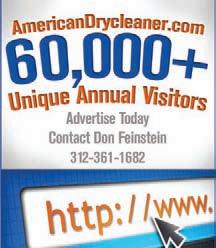
Sailstar P460 D/C. Just taken out of service. Buy whole or parts: otdc@sbcglobal.net or 479-273-2333.
105LB HOYT PETRO-MISER with refrigeration unit. Model PET 105 unit was purchased in 1998 and is in good condition. Asking $6000
60LB EXPLOSION PROOF MARVEL HYDRO-CARBON D/C MACHINE with filter housings. Model EP-60-2BATH. Machine was purchased in 2003 and is in excellent condition. Asking $6000 CALL EDDIE AT 540-494-3316
Plant Manager: Large drycleaning plant in Oklahoma City, OK. Prefer someone with man agement and drycleaning plant experience. Benefits and competitive salary. Email a resume to perryokc@coxinet.net or fax to 405-341-8794.
Tampa, Florida: Mechanic needed for multi-store operation with high volume and expanding rapidly. Salary based on experience and know how. Must have at least 3 years experience in a dry cleaning setting. Please apply on-line at qpcleaners.com
MARVEL CLEANING MACHINE ALL PARTS WANTED North Pointe Cleaners Wisc. - 414-704-3080
SELL OR BUY A DRYCLEANER. WE HAVE BUYERS!!! PATRIOT BUSINESS ADVISORS SPECIALIZES IN SELLING DRYCLEANERS IN NJ, PA, DE & MD. CALL LILIANE AT 267-391-7642.
Price’s Cleaners, Plymouth, IN. Dry-cleaning and shirt laundry. Turn key. Business, building and lot. Priced to sell. In business 43 years. Lot: 60 X 188 ft. Building: 2702 sq. ft. Corner lot. Busiest street. Restaurants, church and offices near. Retiring. 574-936-9021.
www.AmericanDrycleaner.com
W ITHOUT-A-TRACE WEAVERS— More than 50 years’ experience. We are the experts in silks, knits, French weaving and piece weaving. Reasonable prices. Send garments for estimate to: 3344 W. Bryn Mawr, Chicago, IL 60659; 800-475-4922; www.withoutatrace.com.
LEATHER-RICH INC. Since 1977
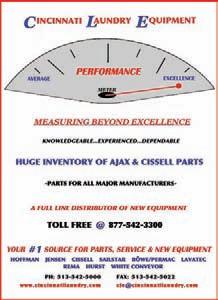
High quality cleaning, refinishing & repair Leather, Suede and Fur; Free shipping in USA and rewards program;
FOR MORE INFORMATION: Email: leatherrich@att.net Call 800-236-6996 Route Service in Upper Midwest
www.americandrycleaner.com American Drycleaner, March 2013 59
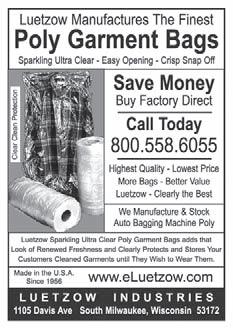

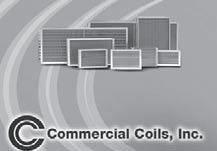
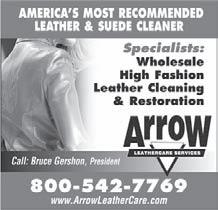
American Drycleaner and AmericanDrycleaner.com
E-News Web Print
American Drycleaner is the industry’s premier publication for news relating to dry cleaning plants. In it, you’ll find profiles of successful businesses and their owners, tips for running your operation more successfully, expert advice, and much more.
AmericanDrycleaner.com is your one-click site for all of the most up-to-date information on the industry today. Stories are updated daily to ensure you’re always informed. Plus, online tools such as the Distributors Directory and Buyer’s Guide will fulfill all of your plant’s needs.

Visit us at the Clean Show in New Orleans June 20-22 — Booth 4171
American Drycleaner, March 2013
than cotton, absorbent, easy to dry, and has a texture similar to cotton and linen. Pineapple cloth is considered that fifth natural textile after cotton, linen, silk and wool, and can be easily woven with other materials, the company says. While the National Cleaners Association (NCA) is unsure of the fabric’s cost, or whether pineapple fabrics will even make their way to the U.S., the organization ensures that it will plan proper protocol for cleaners to follow should pineapple pleated pants begin to appear in stores to be dry cleaned.
50 YEARS AGO. The resurgence of nylon is about to hit the dry cleaning industry, as the Wall Street Journal is reporting that the material will make its way into a variety of clothing and home furnishings in the coming years. The Journal touts the fabric as a “new sales sensation,” specifically because nylon’s molecular structure can be rearranged and molded into permanent shapes. The material will no longer be exclusive to ladies stockings, as nylon is being weaved into slacks, beach wear, dresses, carpets and upholstery. DuPont, which is currently testing a stretch suit, has poured $50 million into new facilities. The company expects the use of nylon in dresses will multiply five times in the next four years … Attaching a flower or ribbon on formal wear through safety pins has become en vogue amongst many women across the country. Fred Pertosoff, owner of Darlene Cleaners in Levittown, Pa., took note of this trend and has begun offering safety pins as premiums to his customers. Pertosoff cleans a heavy volume
of party dresses and formal wear and has begun attaching various-sized pins with each dry cleaned formal garment. Because of his consideration, the Safety Pin Research Council awarded him a “Golden Pin Award” for his distinct customer service.
75 YEARS AGO. Though many cleaners may still be processing wool coats and winter wear, the fashion industry is already anticipating the arrival of summer outfits. One such fabric that cleaners can expect is Congo Cloth, a fabric made of patented yarn containing spun rayon. Its manufacturer, Brand & Oppenheimer, has worked out a solution with the National Association Institute of Dyeing & Cleaning on how to dry clean the fabric. It first recommends pre-spotting the garment with dry solvents, but avoid using a bone scraper or a stiff brush. The next step would be to dry clean in a strong soap solution, avoiding mechanical action wherever possible. In such cases where further stain removal is needed, it suggests referring the garment back to the pre-spotting department, or having the entire garment wet cleaned. … Where there’s smoke, there’s smoke stains, and Joe Schaub of Wisconsin Dye Works has found the solution to extinguish this dilemma. First, he applies full-strength ammonia, then scrubs the garment with a brush using castile soap. He then rinses the soap out and applies a weakened solution of one part acetic acid to three parts plain water. Once dried, Schaub then applies a half-and-half mixture of pre-spotter and chloroform substitute to remove the carbon and other ingredients that may still be left. All there’s left to do is to dry the treated area using an air gun. O
— Compiled by Carlo Calma
10 YEARS AGO. Wire hangers imported from China may soon face special tariffs, as the U.S. International Trade Commission (ITC) has gotten wind of complaints launched by three U.S.based hanger manufacturers: CHC Industries, M&B Metal Products and United Wire Hanger. Frederick Waite, the lawyer representing the three companies, has reported that China has tripled its U.S. market share in hangers since 2000, having supplied 500 million of the more than 4 billion hangers sold last year. While Chinese manufacturers claim that demand for wire hangers has decreased due to casual clothing, Waite says that the increase in the apparel actually increased the demand for wire hangers last year. The ITC is calling for at least a two-year tariff on Chinese imports, which is pending review by the Office of the U.S. Trade Representative … California’s South Coast Air Quality Management District (AQMD) has announced that its governing board has approved a program that will give dry cleaning businesses in Southern California as much as $10,000 to replace perchloroethylene (perc) dry cleaning equipment with alternative solvent technologies. A total of $2 million in grant money is available to cleaners in AQMD’s district on a first-come, firstserved basis.
25 YEARS AGO. Owners using fluorocarbon-based dry cleaning solvents may soon be forced to turn to other solutions as the country—as well as 23 other major industrial nations in the world—has signed onto the Montreal “protocol” agreement, which will gradually reduce production of all fluorocarbons over the next 10 years. Solvents like Fluorocarbon 113, commonly known in the industry as Valclene, will be affected by the agreement, the International Fabricare Institute reports. Tests show that the compound is responsible for the depletion of the earth’s ozone layer. Considering this, it is expected that the protocol will be ratified by the governments of twothirds of the nations that have signed the agreement. … Pineapples may soon splash across the covers of major fashion magazines, as Japanese textile firm Kenebo Co. has reported that it will soon mass-produce a cloth made from pineapple fiber. The company explains that the cloth is stronger

March 1988

